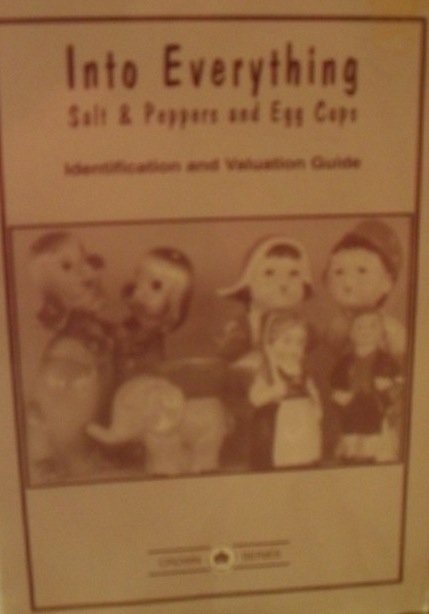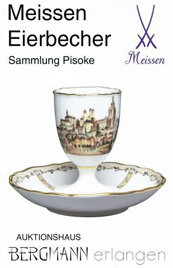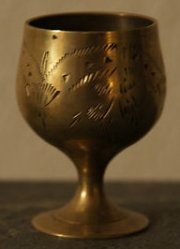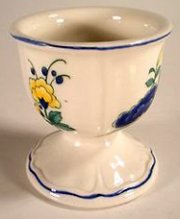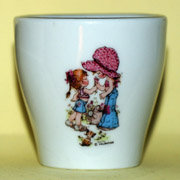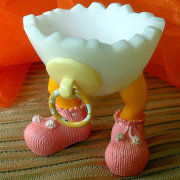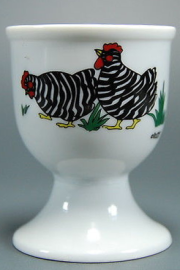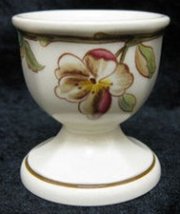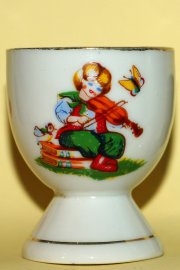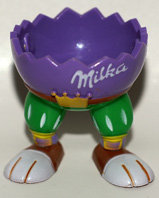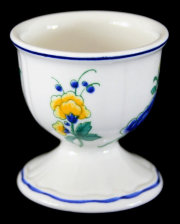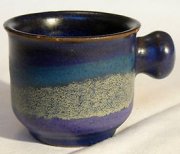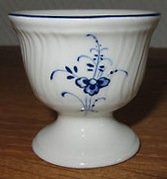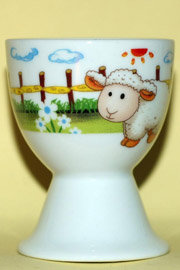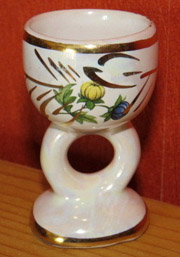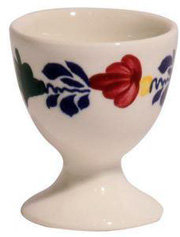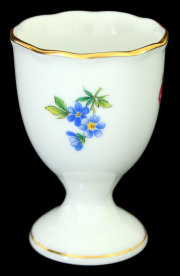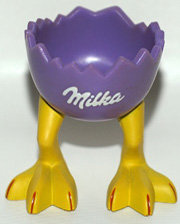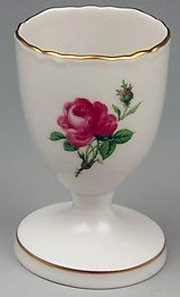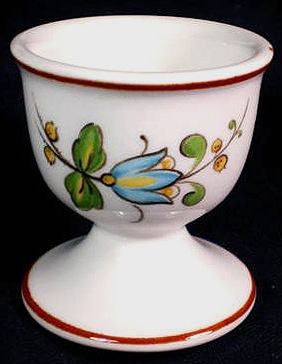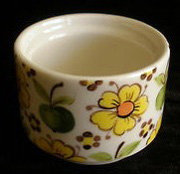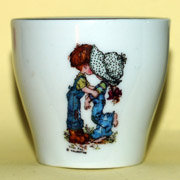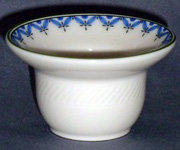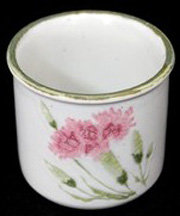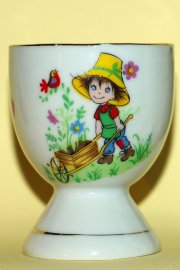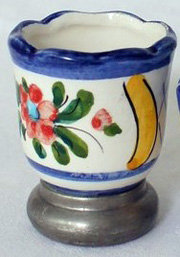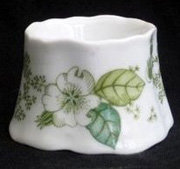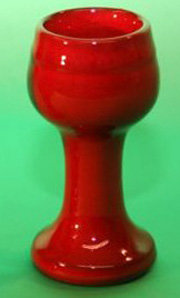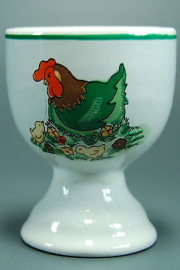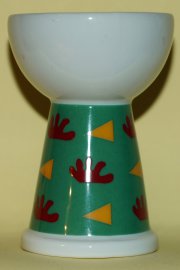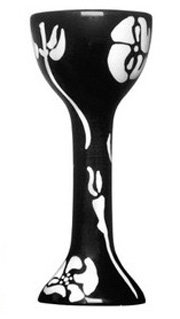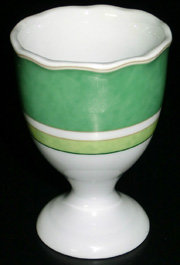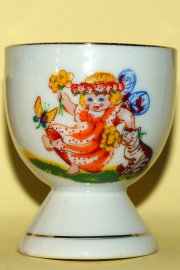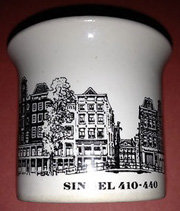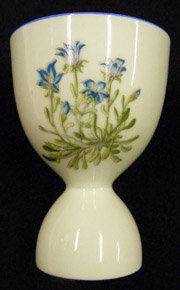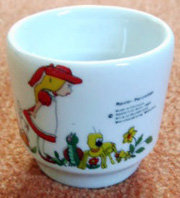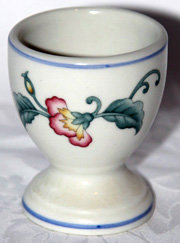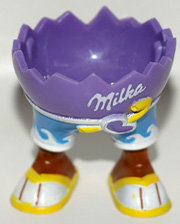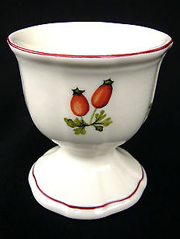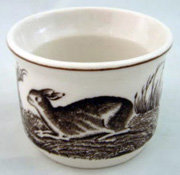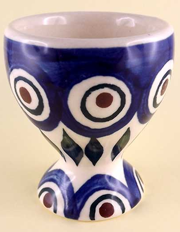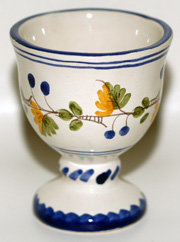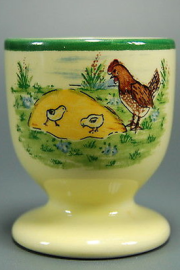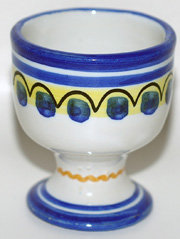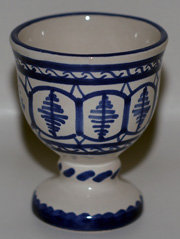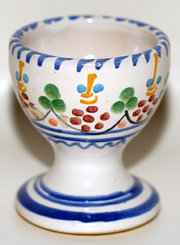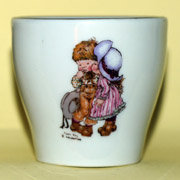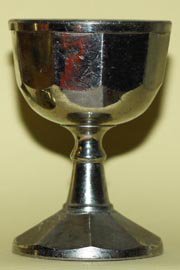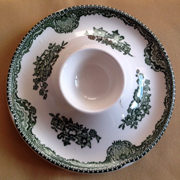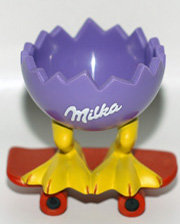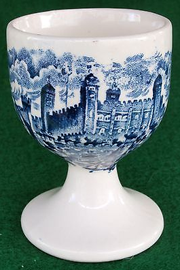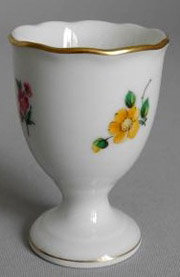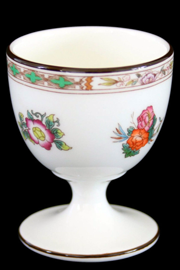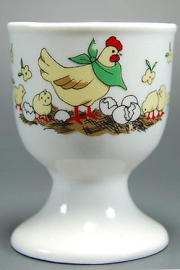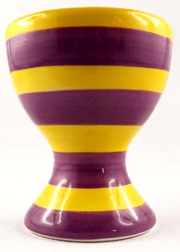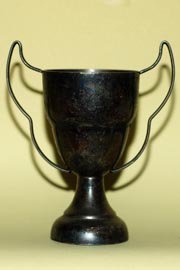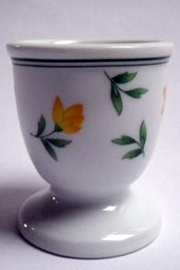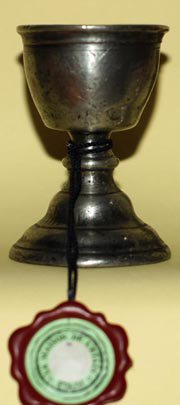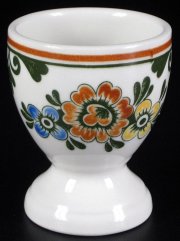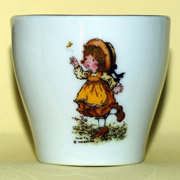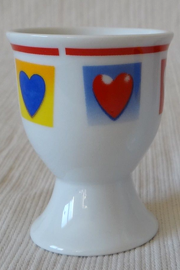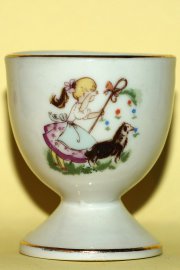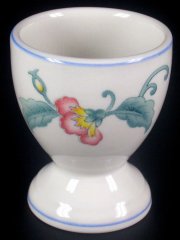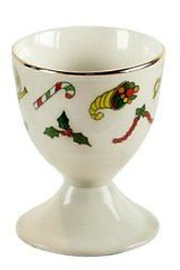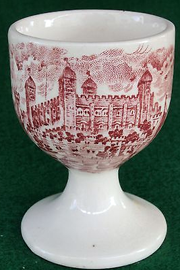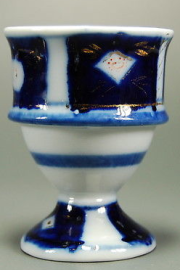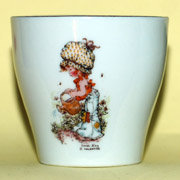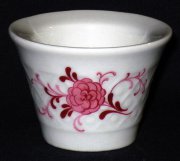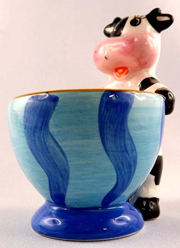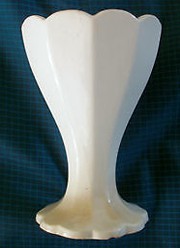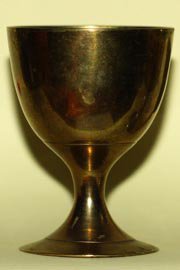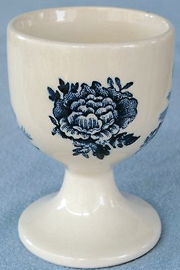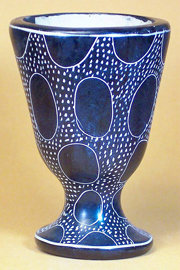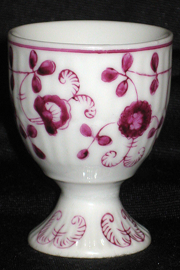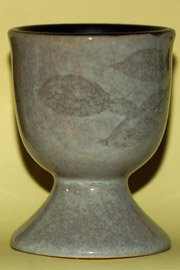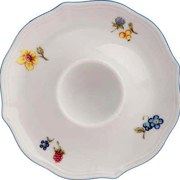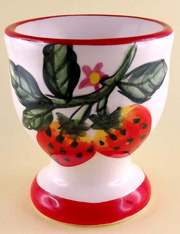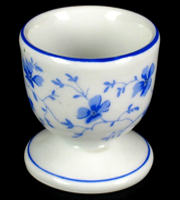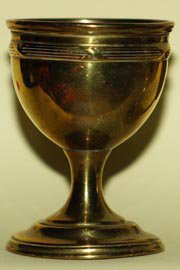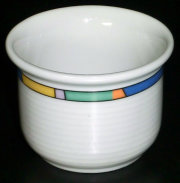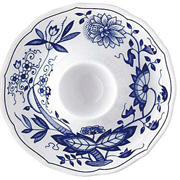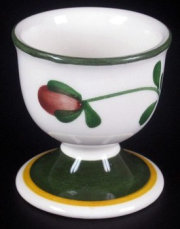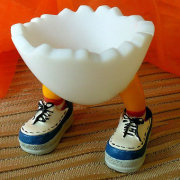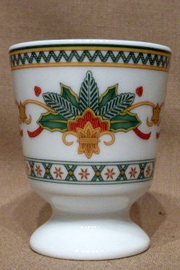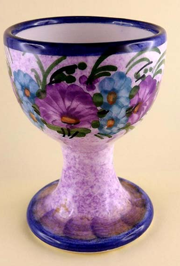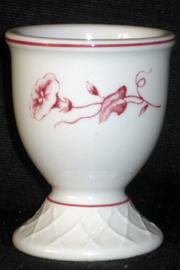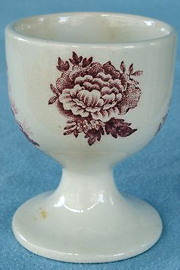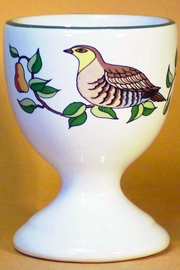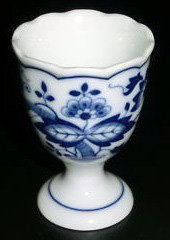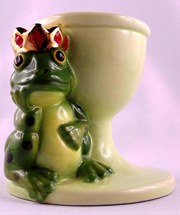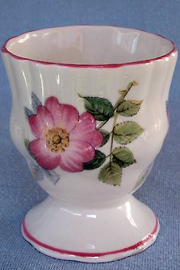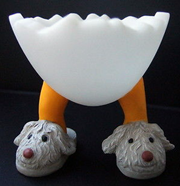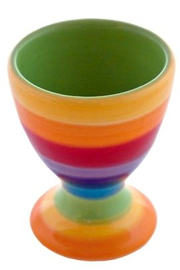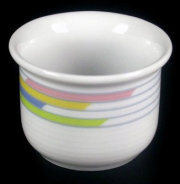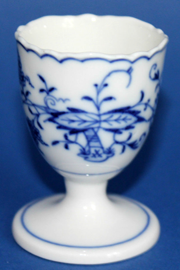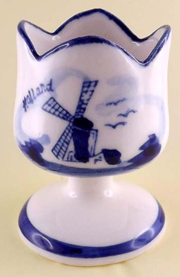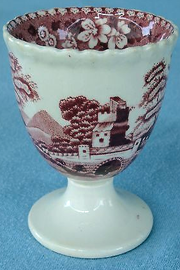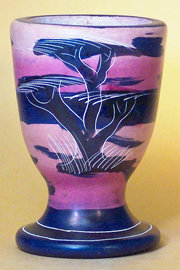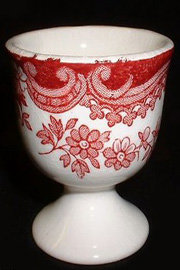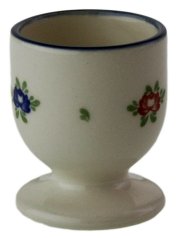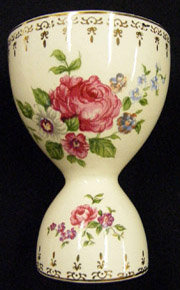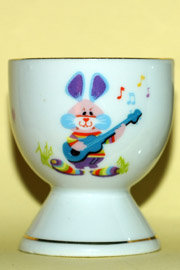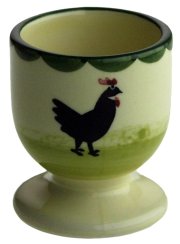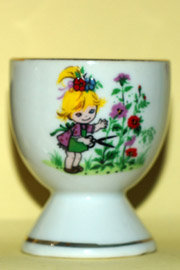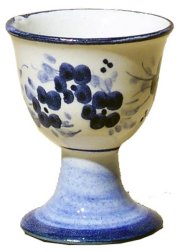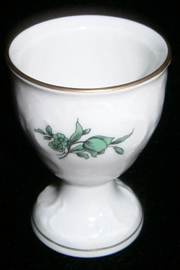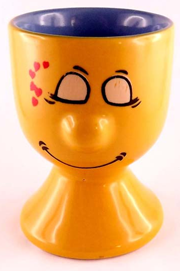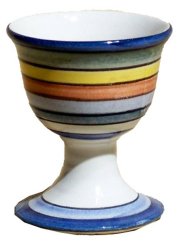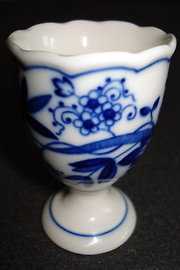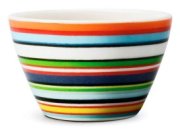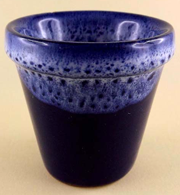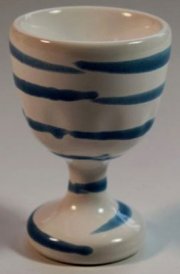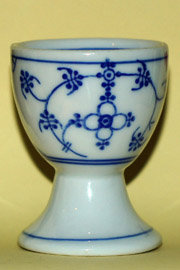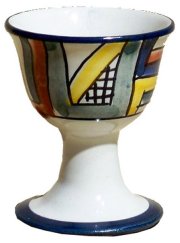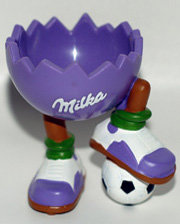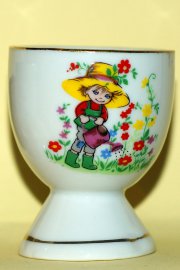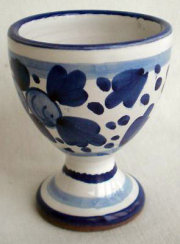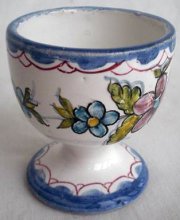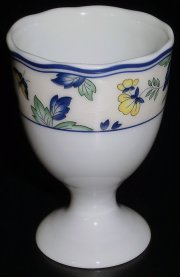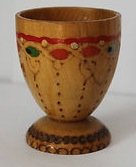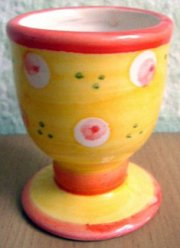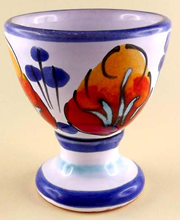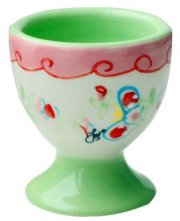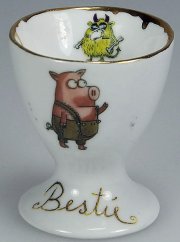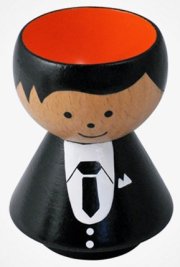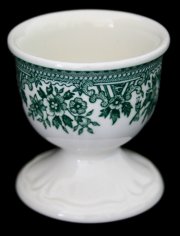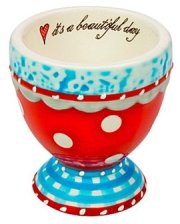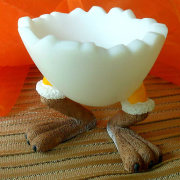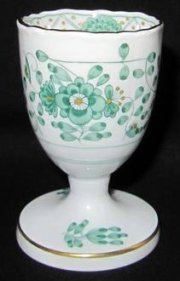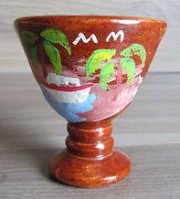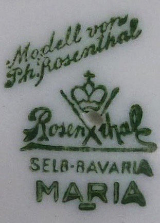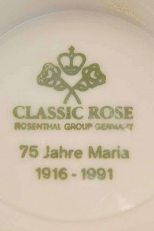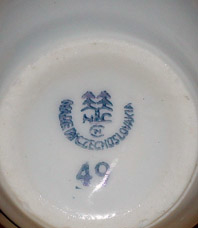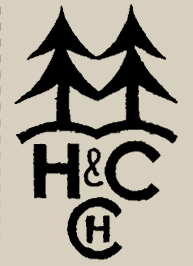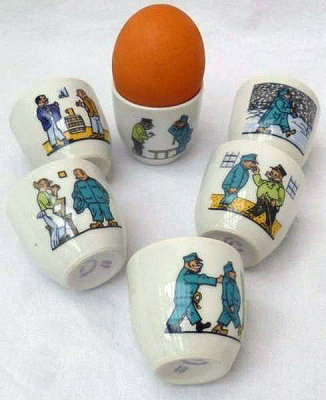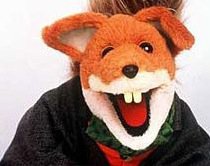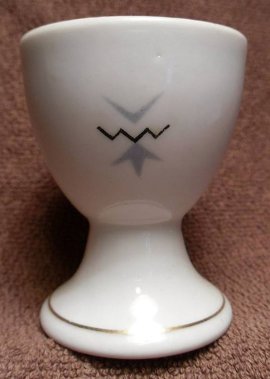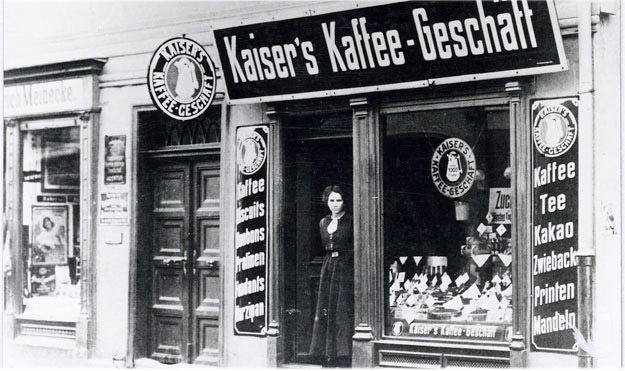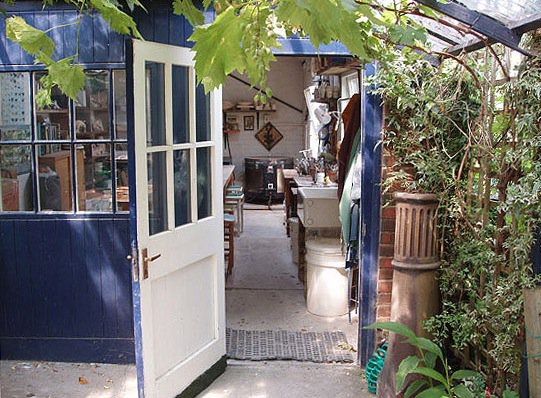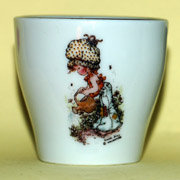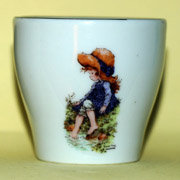Table of contents
| Call for Donations Dear Eggcup Friends, The German Eggcup Museum needs your donations. We have set ourselves ambitious goals that we cannot achieve with our own resources. The purchase of the software and the creation of a large public database swallow most of our funds. Moreover, there are fees and expenses for the webspace, the URL web address, shipping costs, electricity and other overheads for which we need your support. These are all external costs, since all collaborators of the museum work for free for a common goal. Thank you from Nico and the Team |
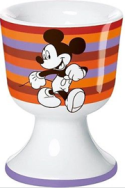

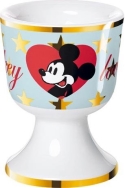
Mickey Mouse Mickey Mouse
Walt Disney (Walter Elias Disney) (born December 5, 1901 in Chicago, Illinois, † December 15, 1966 in Burbank, California) was an American animator and film producer and one of the most influential and most respected personalities in the film industry of the 20th century.
Disney began producing short commercials and cartoons with his first animation studio in Kansas City in the early 1920s before going to Hollywood in 1923 and founding the Walt Disney Company with his brother Roy O. Disney. Other short films, which also used the mixture of animation and real film, were followed in 1928 by the invention of Mickey Mouse, with which Walt Disney became one of the world's best known and most successful film producers within a few years. In the 1930s, he continued to develop the cartoon with his studio, for example by adding tone and colour, to finally publish the first full-length cartoon in 1937 with Snow White and the Seven Dwarfs, which is now considered a milestone in film history. His other films such as Pinocchio (1940), Bambi (1942), Cinderella (1950) and Sleeping Beauty (1959) are also among the best and most popular works in the cartoon genre.
In the course of his career, Walt Disney developed from an imaginative creator of ideas who wanted to perfect the cartoon to America's most popular filmmaker and "nation's fairy tale uncle". His films were popular with a wide audience of all ages, and the cartoon characters Donald Duck, Goofy, Pluto, and others he invented became iconic figures in the entertainment industry. When the Disneyland amusement park opened in 1955, Walt Disney fulfilled a lifelong dream and created the start of a number of other Disney parks around the world. He was also one of the first film producers to use the emerging television in the 1950s to present new films and series and to advertise his studio's work. Disney was awarded a total of 26 Oscars, which has never been achieved before. Even after his death, Disney Studios continued to produce numerous successful films and series, and the name "Disney" became an internationally known brand for a comprehensive selection of products in the entertainment industry.
Egg cups with Disney motifs belong in every well-stocked egg cup collection.




Mickey Mouse Donald Duck Mickey Mouse Mickey Mouse
Mickey Mouse (German Micky Maus) is a cartoon character created by Walt Disney and Ub Iwerks in the form of an anthropomorphic mouse. Due to its worldwide popularity, he is one of the most famous art figures. Mickey Mouse is the most famous character from the Disney world and also appeared as a cartoon character. At first, only seen in cartoons, Mickey Mouse quickly became a comic star and in the following years also a great international success. No wonder that, as can be seen here, he figures on numerous egg cups.
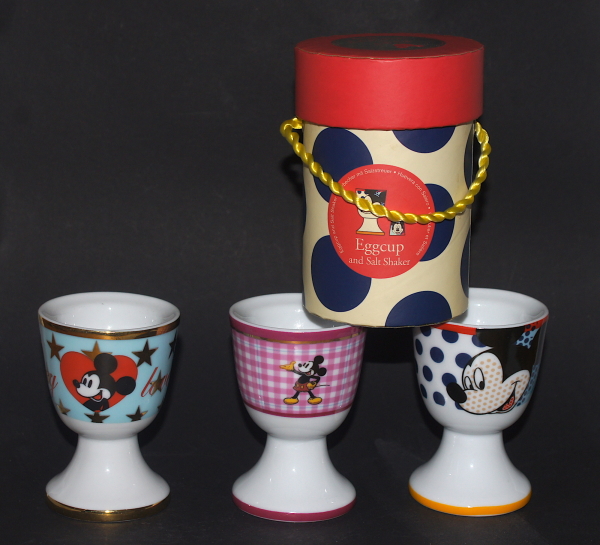
Best of Mickey





These are Huey, Dewey, and Louie
Kwik, Kwek, en Kwak = Dutch – Tick, Trick and Track = German
Knatte, Fnatte och Tjatte = Swedish – Hyzio, Dyzio i Zyzio = Polish





Mickey Mouse Minnie Mouse and Mickey Mouse Mickey Mouse



Mickey Mouse





Mickey Mouse Mickey Mouse Mickey Mouse Mickey Mouse Daisy Duck
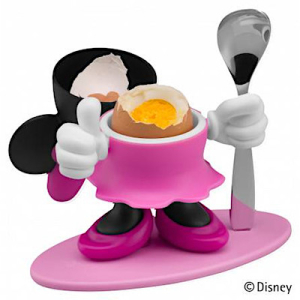
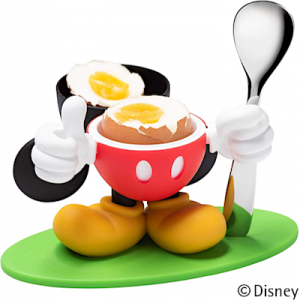
Minnie Mouse Mickey Mouse
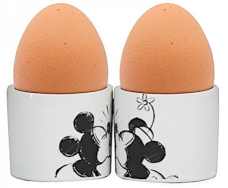
Mickey Mouse and Minnie Mouse

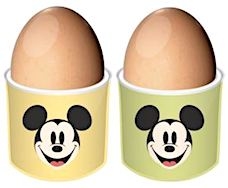
Mickey Mouse und Minnie Mouse Mickey Mouse


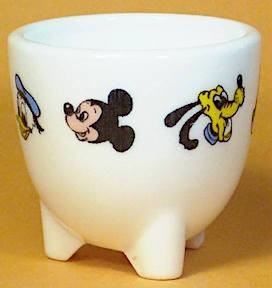
Mickey Mouse Mickey Mouse and Frieds



Minnie Mouse Minnie Mouse Mickey Mouse

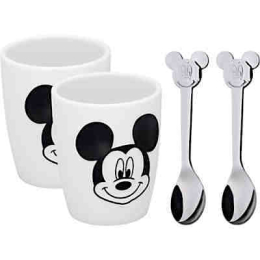
Mickey Mouse Mickey Mouse

Mickey Mouse


Mickey Mouse Mickey Mouse (Japan)

Goofy

Mickey Mouse

 Mickey Mouse Minnie Mouse
Mickey Mouse Minnie Mouse

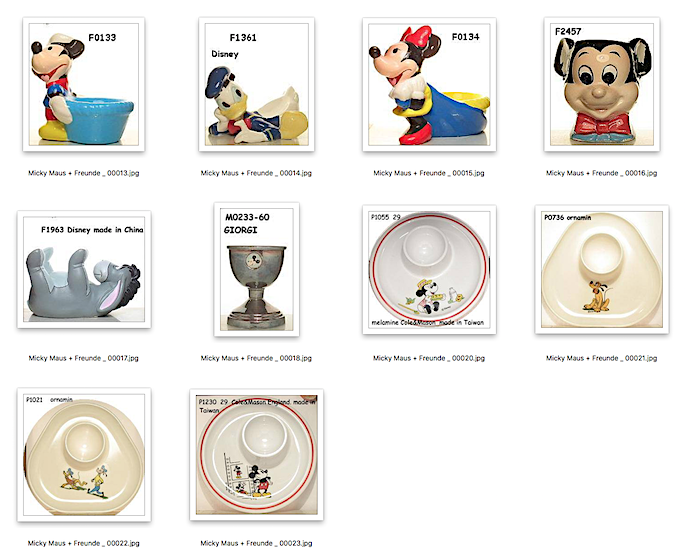
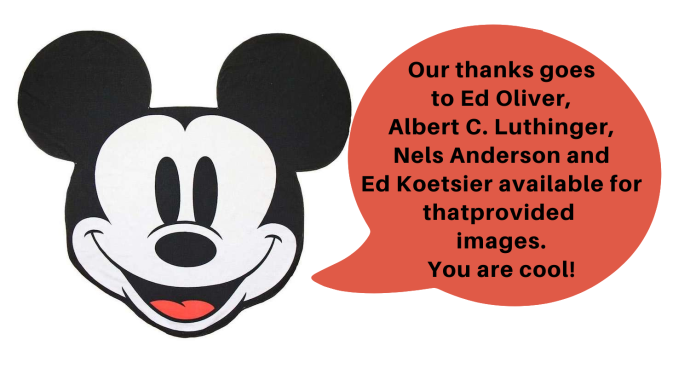
© Nico Diener, German egg cup museum
The names "Walt Disney, "Mickey Mouse", "Daisy Duck", "Goofy" und "Donald Duck" are protected by law,
the use here is only for the exact description of the exhibit and its origin.
Translation: Lesley Kilby
The more than 2,000 shapes and décors of the ceramic manufacture founded in 1748 in France and its many successors with the name Villeroy & Boch are countless. Even the modern factory in Mettlach in the Saar region, Germany does not have an assessment about the number, the shapes and décors of eggcups produced by the factory. Here we would like to collect some of them with mysterious names such as Balmoral, Amado, Nanking, Lanztte or Eonardo.
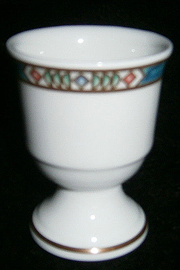
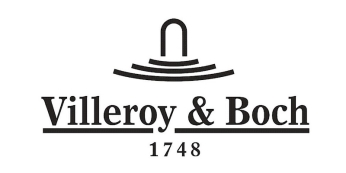
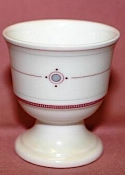
Villa Magica (Heinrich) Aragon (Heinrich)

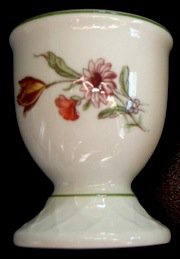
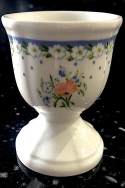
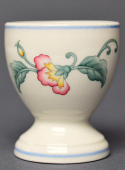
Rosette Tulipe Romantica Delia
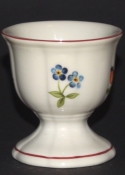
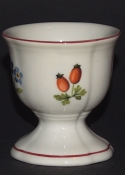
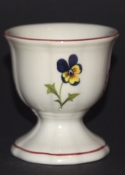
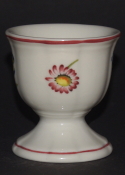
Petite Fleur Petite Fleur Petite Fleur Petite Fleur
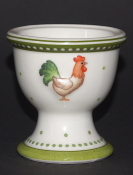
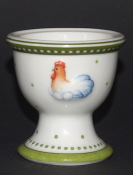
Farmers Spring Farmers Spring
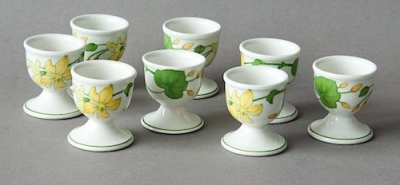
Geranium
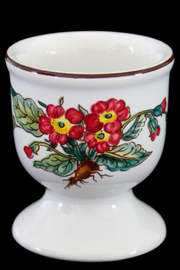
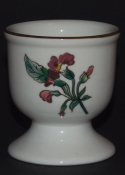
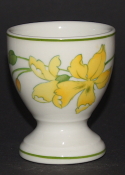
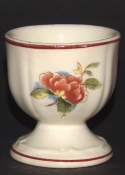
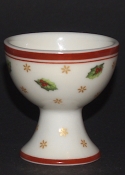
Botanika Botanika Geranium Pfönix rot Delight
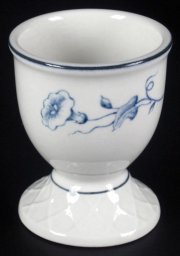
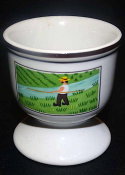
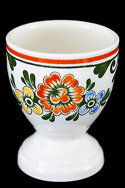
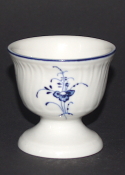
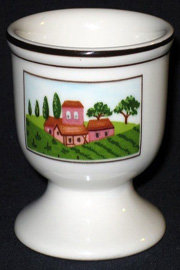
Val Bleu Naif Alt Amsterdam Vienna Naif
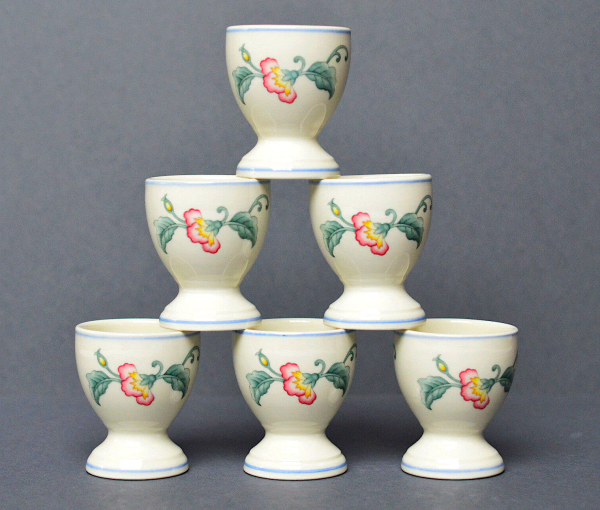
Delia
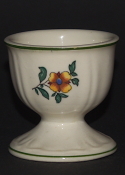
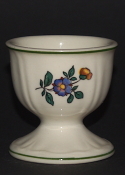
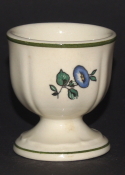
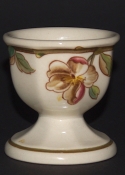
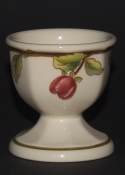
Alt Straßburg Alt Straßburg Alt Straßburg Portobello Portobello
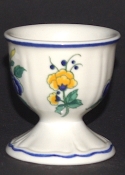
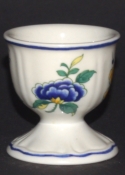
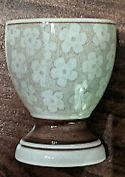
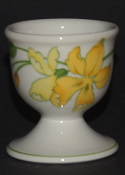
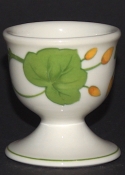
Phönix Blau Phönix Blau Dalarna Geranium Geranium

Botanica
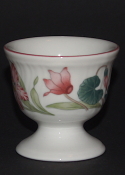
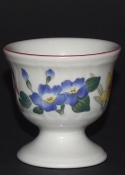
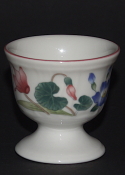
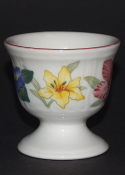
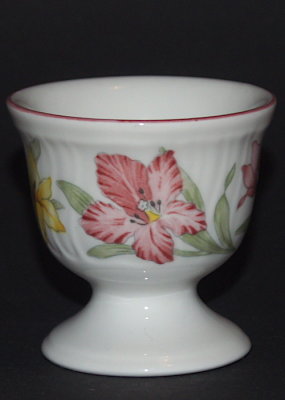
Flora Bella Flora Bella Flora Bella Flora Bella Flora Bella
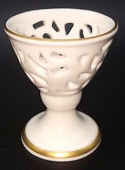
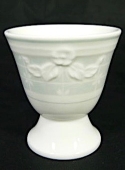

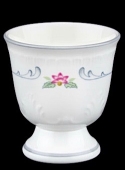

Chantilly Arosio (Heinrich) Chambord (Heinrich) Colier (Heinrich) Villa Magica
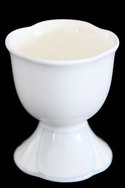
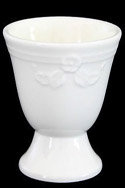
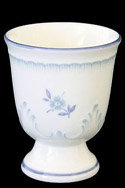
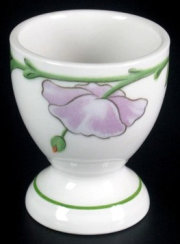
Fiori weiß Vienna Amapola Delte
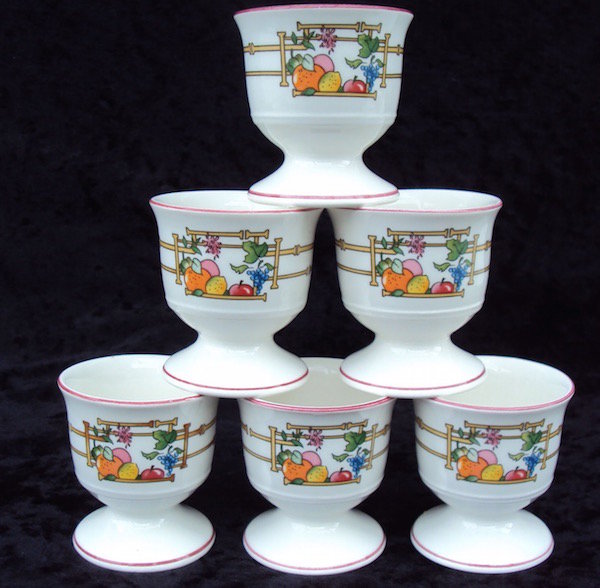
Dekor Mon Jardin
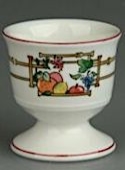
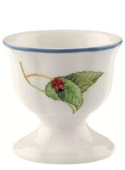
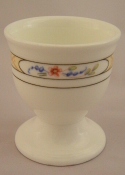
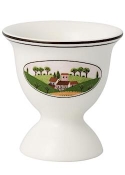
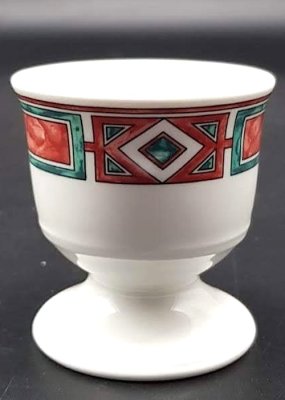
Mon Jardin Cottage Orlando Charmant Rialto
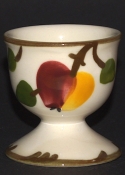
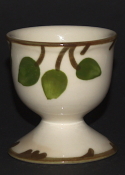
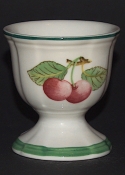
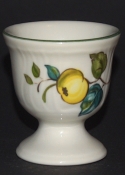
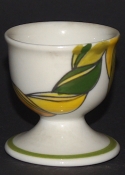
Ma Pomme Ma Pomme Frech Garden Jamaica ?
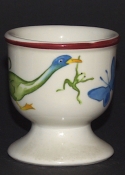
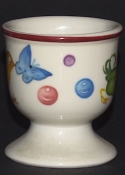
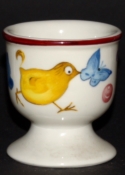
Le Cirque Le Cirque Le Cirque
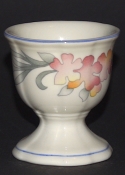
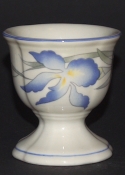
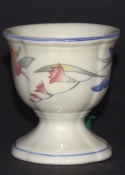
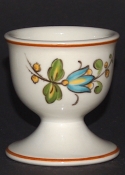
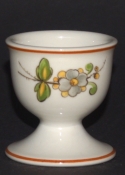 Riviera Riviera Riviera Louisianna Louisianna
Riviera Riviera Riviera Louisianna Louisianna

Dekor Valeria, rot
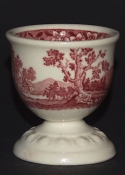
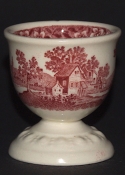
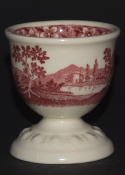
Rusticana rot Rusticana rot Rusticana rot
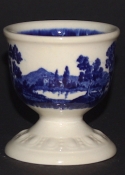
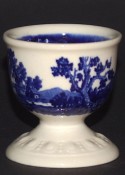
Rusticana blau Rusticana blau
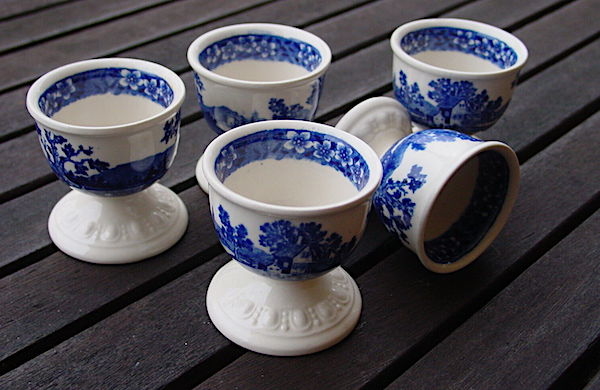
Decor Rusticana blau
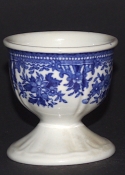
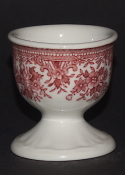
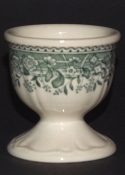
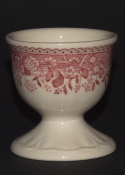
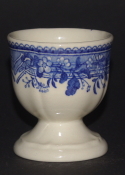 Fasan blau Fasan rot Burgenland grün Burgenland rot Burgenland blau
Fasan blau Fasan rot Burgenland grün Burgenland rot Burgenland blau
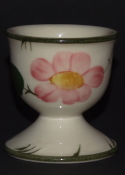
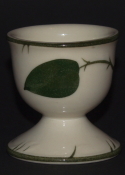
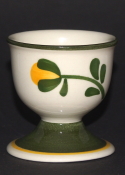
 Wildbrose Wildbrose Bauernblume Bauernblume
Wildbrose Wildbrose Bauernblume Bauernblume
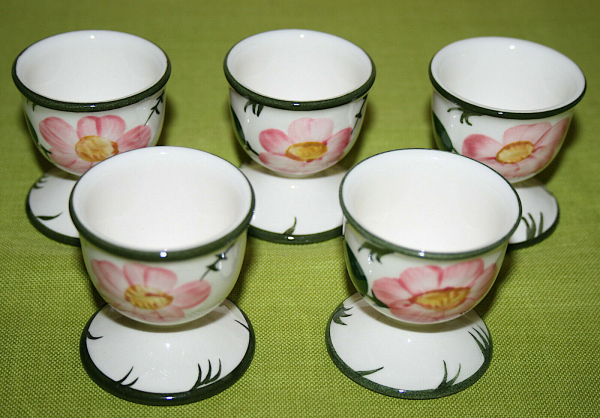
Wildbrose

Gallo Leonardo
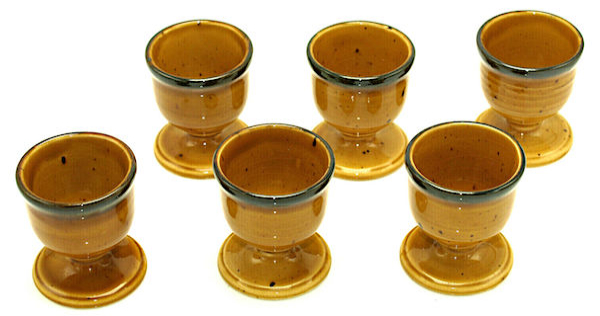
Gallo Provence
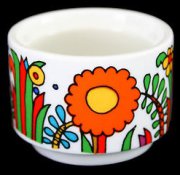
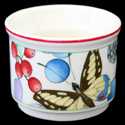
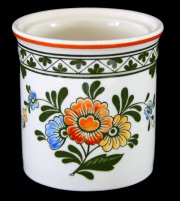
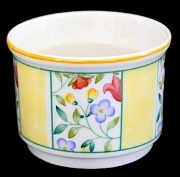
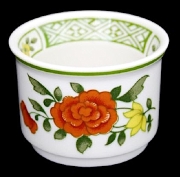 Acapulco Catalina Alt Amsterdam Virginia Summerday
Acapulco Catalina Alt Amsterdam Virginia Summerday
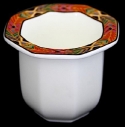
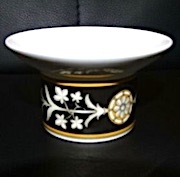
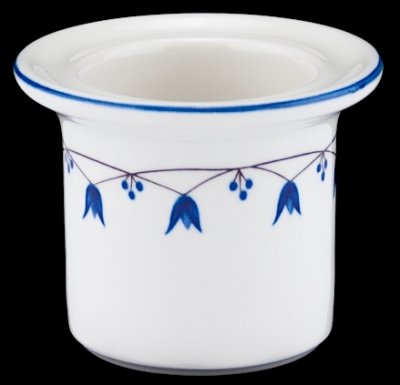
Cheyenne Intarsia Salzburg
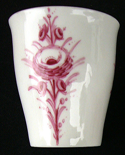
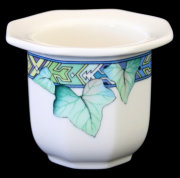
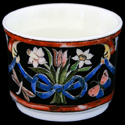
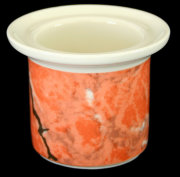
Rote Rosenranke Pasadena Intarsia Sienna
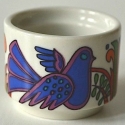
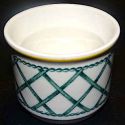
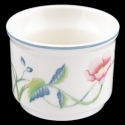
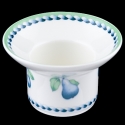
Acapulco Basket Albertina Provence
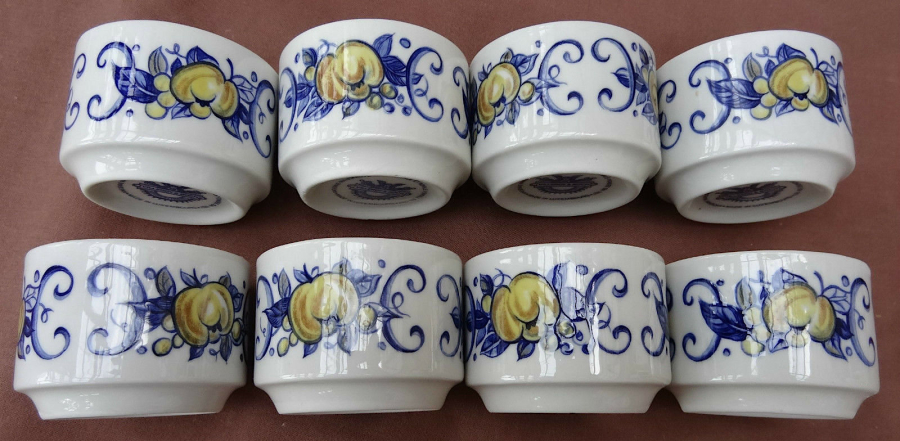 Seris Cardiz
Seris Cardiz
Photos: Diener, Koetsier u. A. © Nico Diener, German egg cup museum
Translation: Dr. Anna de Vincenz
The name "Villeroy & Boch" is a protected by law. The use here facilitates the exact description of the exhibits and their origin.
Egg cup with pierced decoration German 
Piercing porcelain is a decoration for dishes, created using a special technique. When it is finished, it looks like this pastry dish by Schumann.
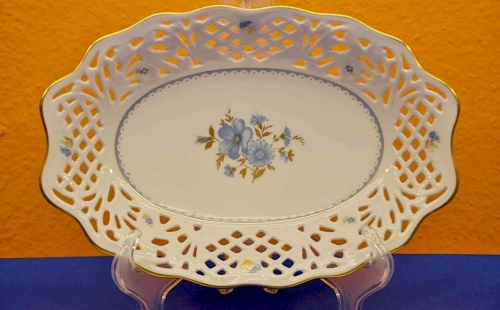
Piercing consists of a decorative hole in the wall of the tableware that is cut along a perforation with a special knife when the clay is leather-hard but not fired. The cutout is then pushed inwards and the clay is pierced. Afterwards it is fired.
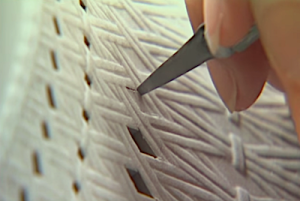
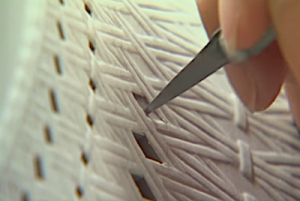
Porcelain piercing, image: KPM, source: YouTube screenshot
Piercing is a technique, rarely found in egg cups, which makes such a collector's item particularly valuable. The Royal Prussian Porcelain Factory, Schumann, Rosenthal, Hutschenreuther, Meissen, Fürstenberg, Lindau Castle, Arzberg and Kaiser are leaders in the production of pierced dishes.
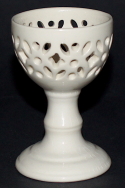

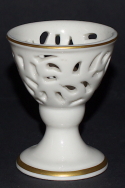

 1 2 Philippines (V&B) Germany 5
1 2 Philippines (V&B) Germany 5





6 7 8 9 10



Tunesia Tunesia Tunesia
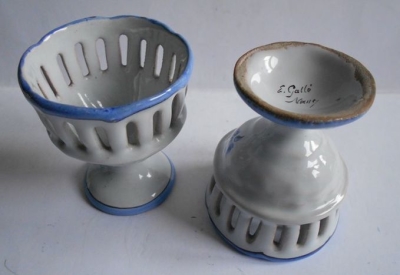

Émile Gallé, Nancy around 1890
Similarly, as can be seen here, it is and was possible to bore through the walls or create holes with other sharp-bladed implements.





18 19 20 21 22
A completely different kind of design is achieved by braiding with thin sausages rolled from porcelain. The special decoration is first made flat on a mat before cutting and shaping.
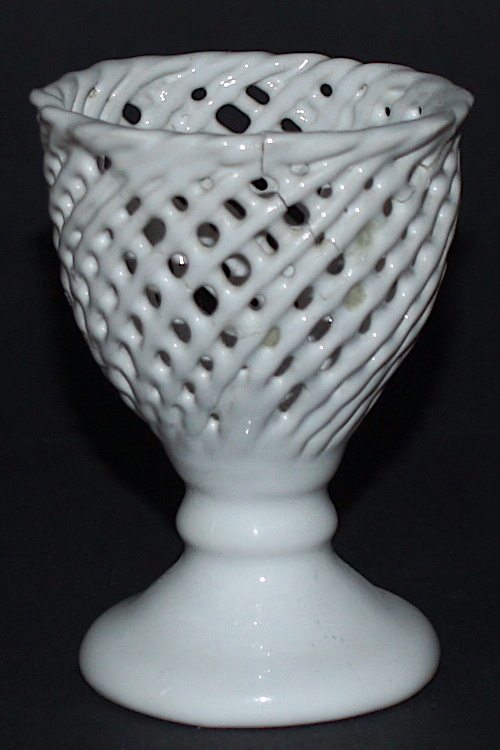

23 24
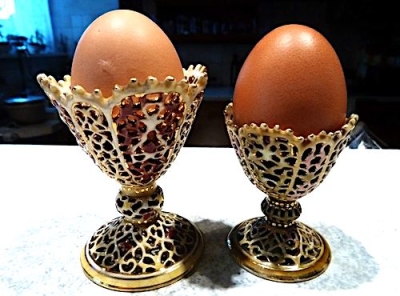
Moritz Fischer, 1839. Made in Herend Ungary
Photos: Diener, Koetsier, Fumey, Selhorst, Luthinger © Nico Diener, German egg cup museum
Translation: Lesley Kilby
The names Königlich Preußische Porzellanmanufaktur, Schumann, Rosenthal, Hutschenreuther, Meissen, Fürstenberg, Burg Lindau, Aztberg, Kaiser and Émile Gallé are protected by law, the use here is only for the exact description
of the exhibit and its origin.
Cook a Doodle Doo German 
This egg cup and saucer is a "good morning egg cup" for a good morning.
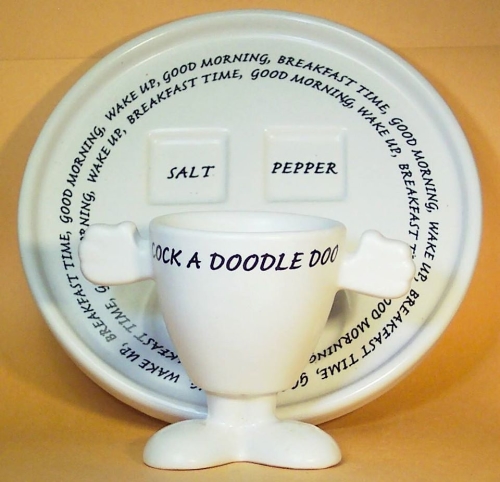
Cook a Doodle Doo is also a well-known English nursery rhyme.
Photo: Nels Anderson © Nels Anderson, Louisiana
The name "Cook a Doodle Doo" is protected by law, the use here is only for the exact description
of the exhibit and its origin.
The present text was translated from German using a modern translation program.
If you have any improvements, please send them to us by email:
DeutschesEierbecherMuseum@ist-einmalig.de
Egg cup from Greengate a good bit of Denmark German 
"We believe that the simple, everyday moments in life can be the most memorable and valuable. In a complex world where less time is available, we want to help slow down time - by enriching each of these little moments together and give it more meaning. Each of our products is based on this philosophy and how we manufacture it is also based on this philosophy ". The Danish company Greengate writes on its current website.
In other words: live every day and every moment of your life and make every moment unforgettable. Here are a few design and design examples of the special Scandinavian feel-good atmosphere and the Greengate philosophy in the picture:
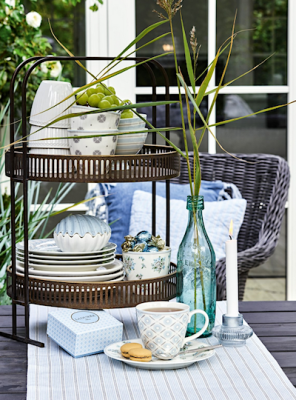
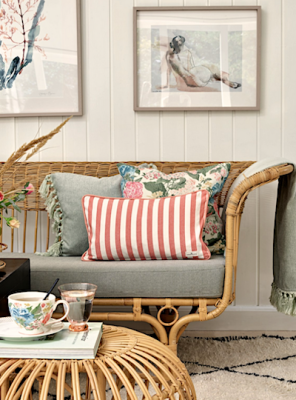
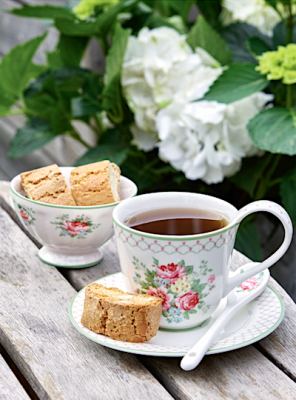
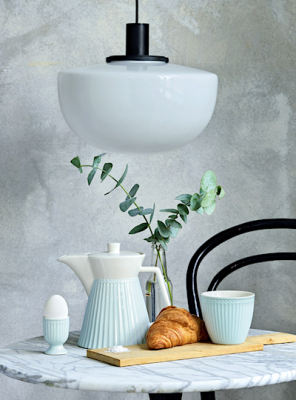
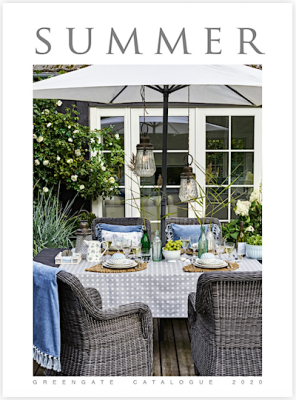
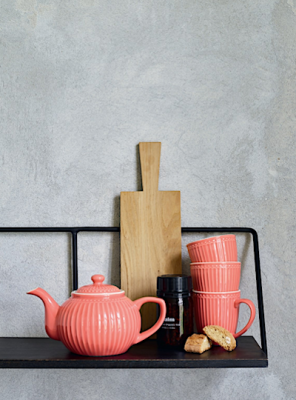 To the current Greengate catalogue
To the current Greengate catalogue
Each collection begins with the Greengate design team leafing through books and carefully selecting the best designs that fit the trends of the coming season. The designs were developed, modified and given new colours to reflect the Nordic background of Greengate's founders and designers.
The end result is a perfectly coordinated ensemble of home accessories, dishes, tablecloths, cutlery, kitchen utensils, pillows, table decorations and bags. The smallest and most useful dish, the egg cup, is of great importance. Footed or bucket shape and in over 50 different designs, it is a highly sought-after item in most egg cup collections.
As the Greengate designs are only ever produced for a short time, new ones are added every year, as a look at eBay shows, the prices for itmes sought after by collector and enthusiast have risen sharply. In contrast to other egg cups made of stoneware and in the "tableware" category, this means prices are relatively high.
The version with a classic foot is 6.5 cm high.
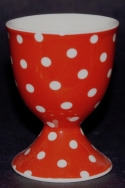
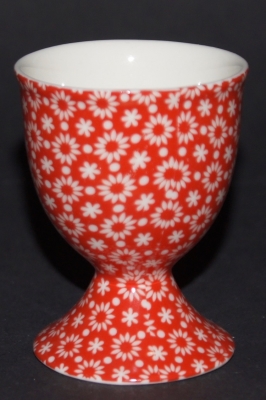
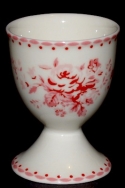
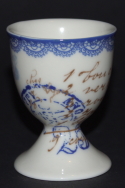
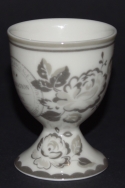
Spot red Linda red Abelone raspberry Fay white Dora white
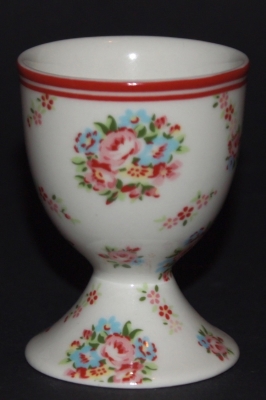
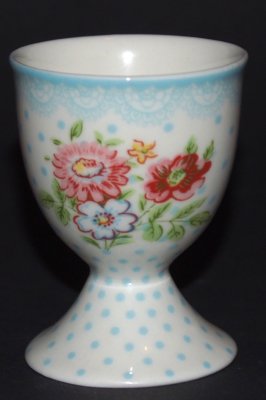
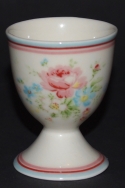
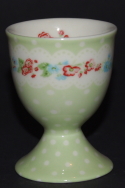
Sophia white Wendy white Marie l pale blue Ivy green
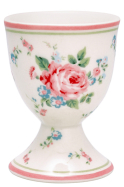
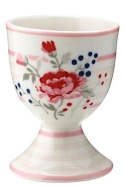
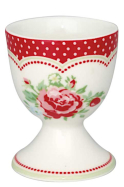
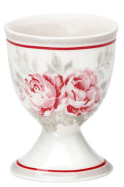
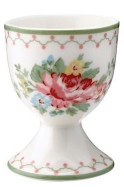
Marley petit white Fiona pale Pink Mary white Shirley Linen Aurelia white





Gabby white Heidi green Betty mint Simone white Nicole white


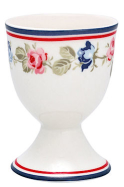


Rose white Sophie Vintage Hailey withe Malou white Flora white
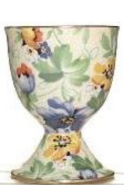
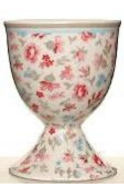

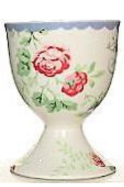

? Tilly off white Adele white Rosie white Lily petite weiß



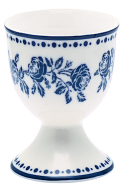
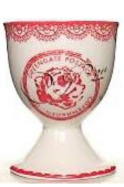 Stephanie green Stephanie red Fleur blue Fay red
Stephanie green Stephanie red Fleur blue Fay red

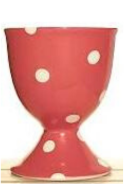
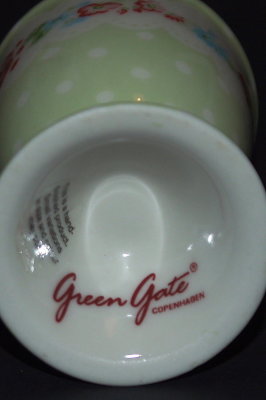


Star small white Dots rot Stempel Dots pale blue Dots warm grey
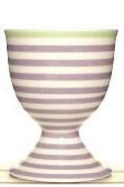
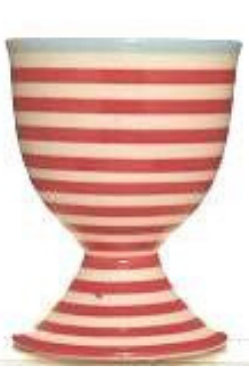

Juliet lavender Juliet red Lulu mint
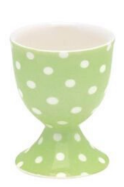
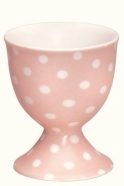
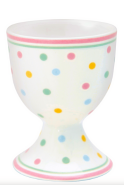
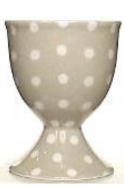
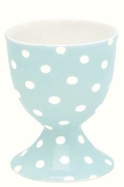
Spot green Spot pink Bonnie white Spot grey Spot mint
The bucket shape is 4.5 cm high.
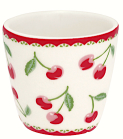
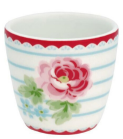
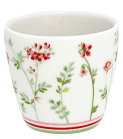
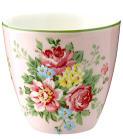
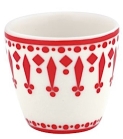
Cherry white Lily white Rose Camille white Aurelia white Fleur red

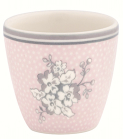
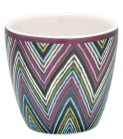
Amanda indigo Ella pale pink Zindy dark grey
In addition to the colourful patterns that have made Greengate products so popular, there is also a classic tableware that Greengate calls "EVERDAY". The dishes from this series are exclusively two-tone. They are white on the inside and available in 12 different colours on the outside.
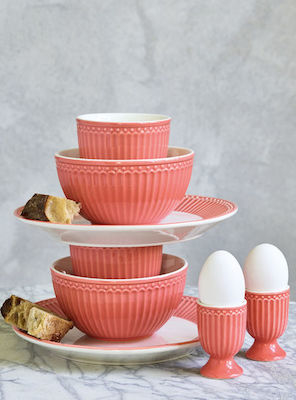
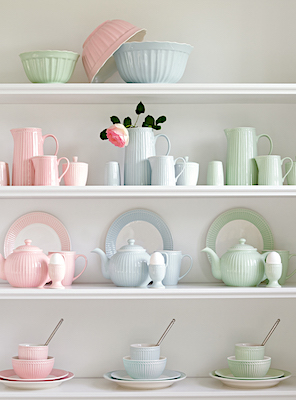
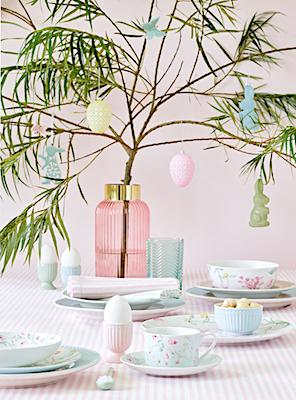
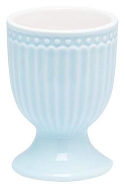
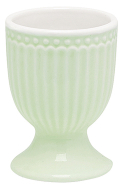
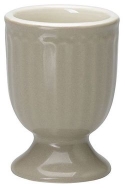
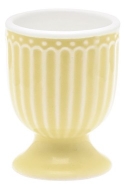
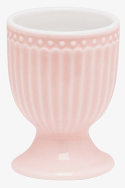 Alice pale blue Alice pale green Alice pale warm grey Alice pale yellow Alice pale pink
Alice pale blue Alice pale green Alice pale warm grey Alice pale yellow Alice pale pink
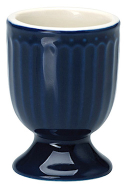
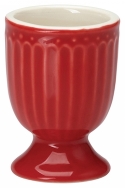
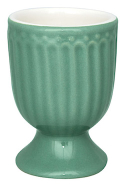
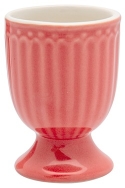
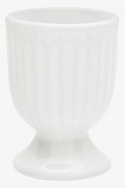 Alice dark blue Alice dark red Alice dusty green Alice coral Alice white
Alice dark blue Alice dark red Alice dusty green Alice coral Alice white
The selection is completed by another premium range, called "GATENOIR". The magnificently decorated tableware, including a few egg cups, can be a gem in any egg cup collection.
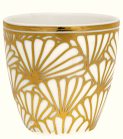
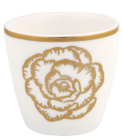
Jaqueline gold Blossom gold
Photos: Greengate, Diener, Koetsier, www © Nico Diener, German egg cup museum
Translation: Lesley Kilby
The name "Greengate" is a protected by law.
The use here facilitates the exact description of the exhibits and their origin.
Royal Doulton – Bunnykins German 
Royal Doulton Bunnykins tableware and figurines are popular ceramic designs of children's tableware and collectible figurines. The porcelain line was created in the 1930s with works of art by Sister Mary Barbara Bailey (nee Barbara Vernon Bailey), the daughter of Cuthbert Bailey, general manager of Doulton.
Unknown to the public, Mary Barbara Bailey was not a professional illustrator, but a nun in the Lateran Augustinians. Sister Mary Barbara provided Doulton & Co. designers with illustrations to be used for dishes. Production ceased in World War II and only resumed in 1969. The tableware was manufactured in England until 2005. A very small-scale collection is currently being made in Asia, but egg cups are not included.
The Bunnykins tableware, introduced in 1934, shows Mr. and Mrs. Bunnykins and other rabbits in human clothing in colourful English rural and village scenes in transfer printing on white porcelain. The earliest pieces, signed "Barbara Vernon" (Sister Mary Barbara Bailey), are quite rare and highly valued today. Bunnykins China was used by Princesses Elizabeth and Margaret and became a popular gift to mark a christening and birth in middle-class English homes. Sister Mary Barbara Bailey stopped producing drawings for Doulton & Co.in 1950.
Royal Doulton Bunnykins dishes are available as two-handed cups that are very popular with children and all kinds of dishes and decorative items. Including money boxes and ... (see below)
The figures by Charles Noke were produced from 1939 with various Bunnykins figures. The Bunnykins figure series is famous for the large number of professions, historical and literary figures and traditional costumes, all of which are portrayed as rabbits. Well-known characters include Policeman Bunnykins, Nurse Bunnykins, Sir Lancelot Bunnykins, Betsy Ross Bunnykins, Laplander Bunnykins, Fortune Teller Bunnykins and others. In 2005, a Bunnykins figure was made in honor of Barbara Vernon entitled "Sister Barbara" and shows a nun at her drawing board, who is probably painting the original Bunnykins design.
Footed Bunnykins egg cups were manufactured in the 1950s; the bucket version probably remained in production from the 70s to the end of the 80s.
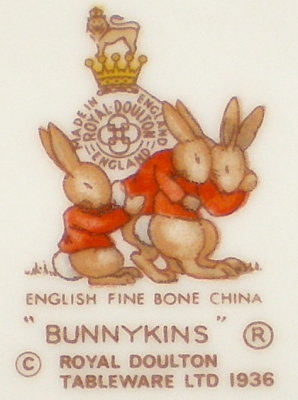 The footed egg cups are rarer with (2020) two pieces will be offered in Canada for the price of $216.00 Canadian dollars (approx. 147.00 Euro) each. The bucket style, however, is more common and this version can be found in many collections.
The footed egg cups are rarer with (2020) two pieces will be offered in Canada for the price of $216.00 Canadian dollars (approx. 147.00 Euro) each. The bucket style, however, is more common and this version can be found in many collections.
Royal Doulton is an English ceramic manufacturer from 1815. Originally based in Vauxhall, London, it later moved to Lambeth and opened a factory in Burslem, Stoke-on-Trent, in the centre of English pottery in 1882. From 1853 to 1902 it used the name Doulton & Co., after which time this was changed to Royal Doulton.
Three of the company's brands were Royal Doulton, Royal Albert and (after a World War II merger) Mintons. These brands are now owned by WWRD Holdings Limited (Waterford Crystal, Wedgwood, Royal Doulton) based in Barlaston near Stoke-on-Trent. The acquisition of WWRD by the Finnish company Fiskars Corporation was completed on July 2, 2015.
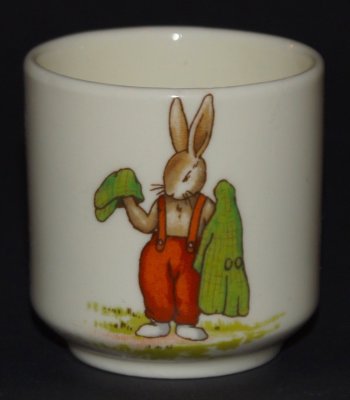
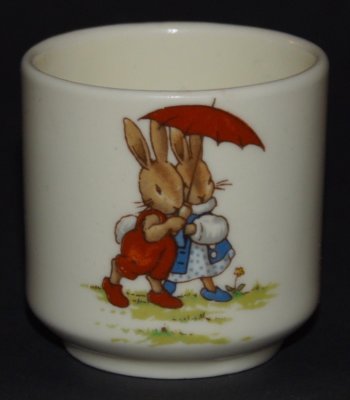
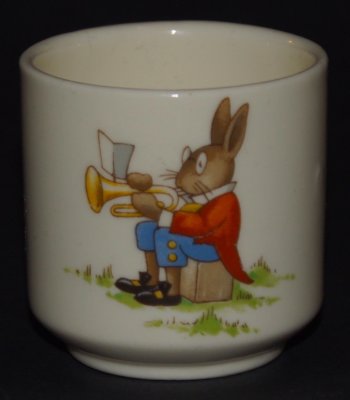
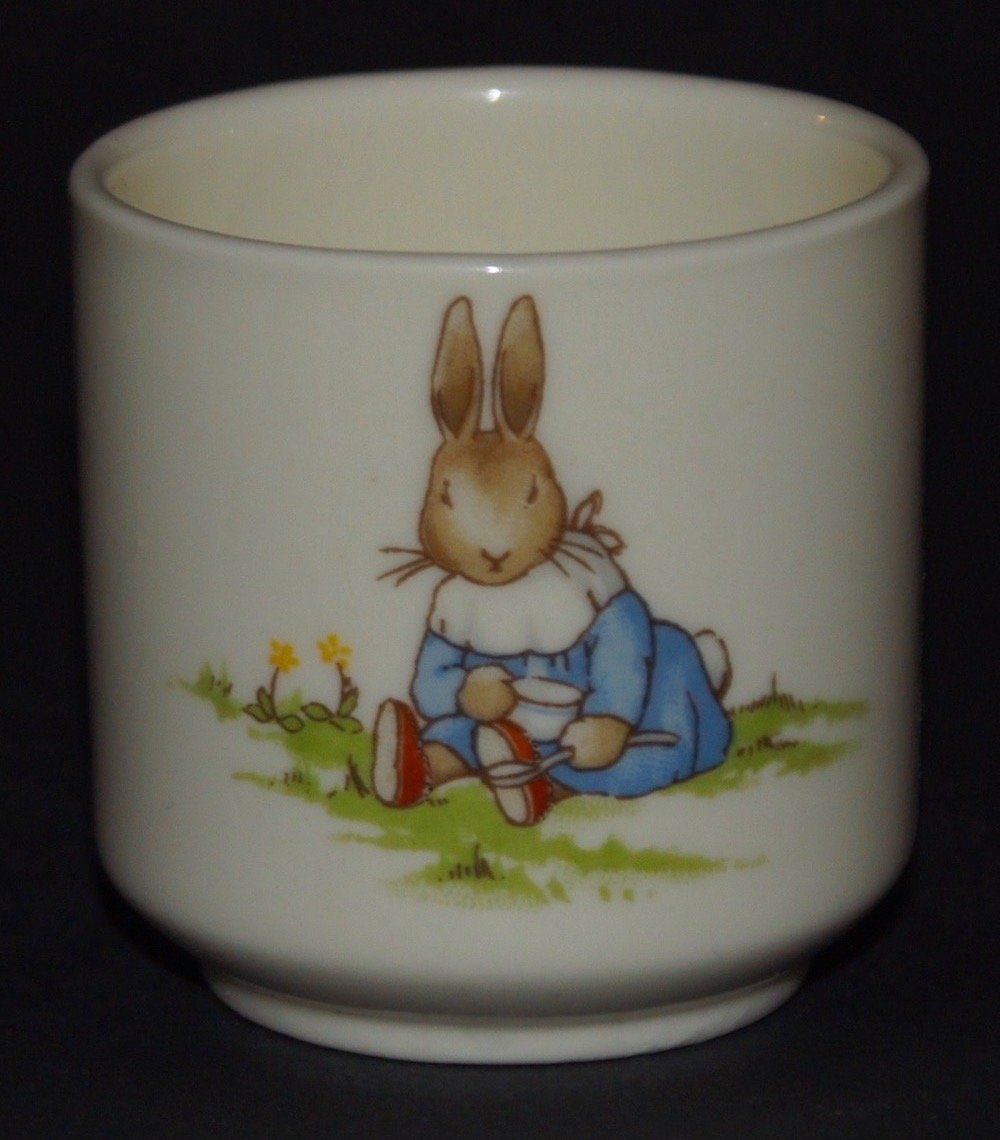
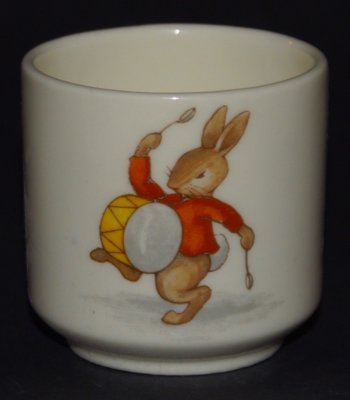
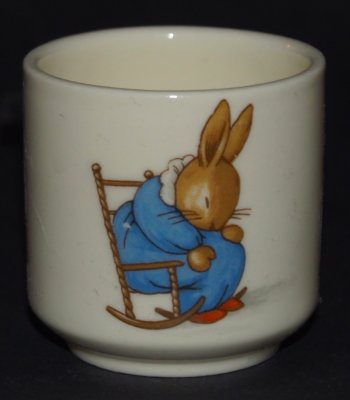



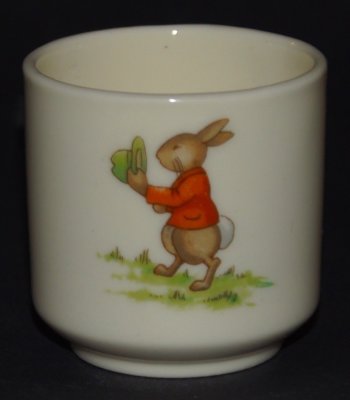
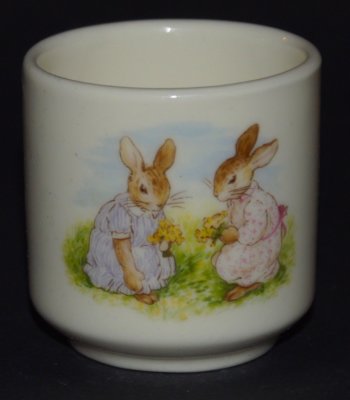
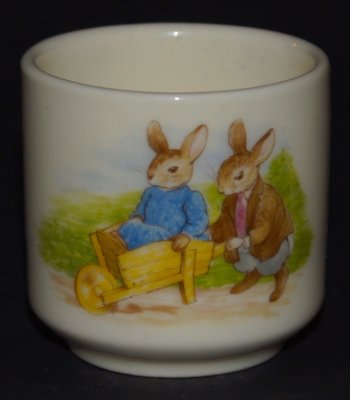
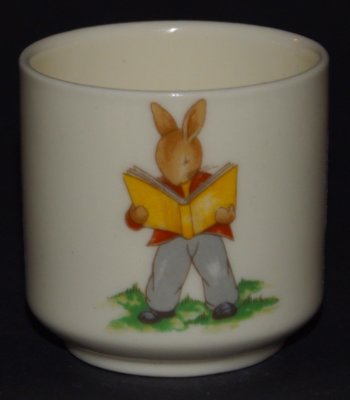

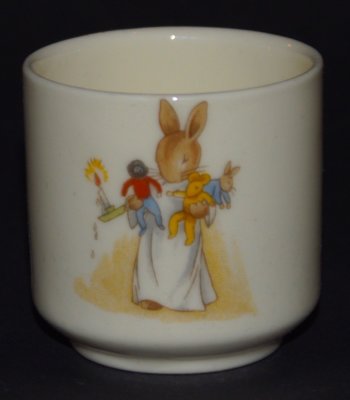

front and back respectively
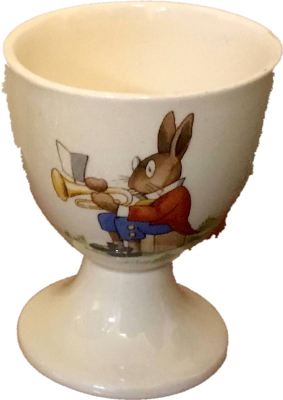

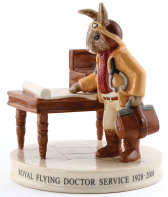
Very rare version with foot Royal Doulton porcelain figurine
Photos: Diener, www © Nico Diener, German egg cup museum
Translation: Lesley Kilby
The name "Royal Doulton" is a protected by law.
The use here facilitates the exact description of the exhibits and their origin
"Success Model Maria" by Philipp Rosenthal German 
Since 1914 the manufacturers Rosenthal produced the "success model Maria"; in the meantime it has appeared in two forms and with more than 50 different patterns. Originally, the well-known eggcup was 7 cm high and had a 10 mm pedestal. Later, the 6 cm high model prevailed with a 5 mm high pedestal. In 1879 the "history of the manufacturers Rosenthal" began. The porcelain painter Philipp Rosenthal, who at the time was already successful, leased Margrave Castle, Erkersreuth in Selb in Upper Franconia (now Bavaria in Germany) and founded his own porcelain painting. 10 years later he moved to Selb and so began the production of porcelain. Over the following years, the company Rosenthal became so powerful that it was able to buy up other factories; sometimes very famous porcelain factories and partly continue with their famous brands. So now the Thomas Porcelain factory as well as Zeidler and brand, belongs as much to the Rosenthal Group as Waldershof and Hutschenreuther. Rosenthal himself was prevented from taking over the Irish Waterford Wedgewood plc by a majority shareholder from 1997. Their successor company sold the 2009 Rosenthal division to the Italian cutlery manufacturer Sambonet Paderno.
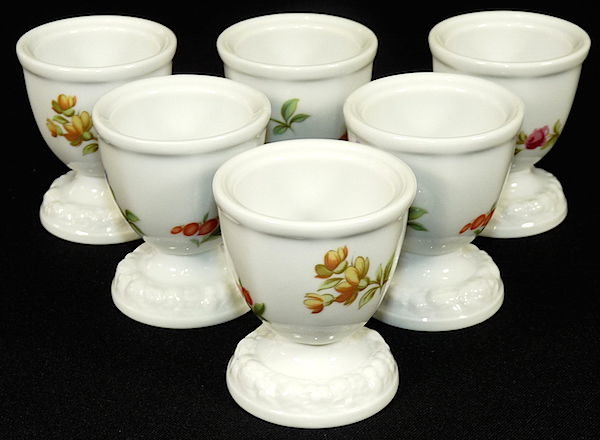
Decor Summer Bouquet, 5 mm, 6 cm high

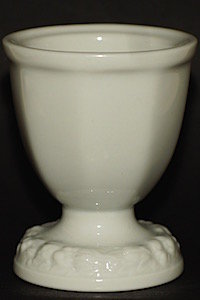
earlier form with 10 mm stand later shape with 5 mm Stand
7 cm height with 1 cm high shaft
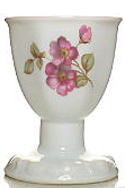
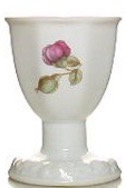
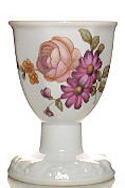
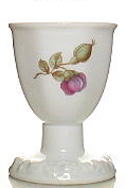
? ?
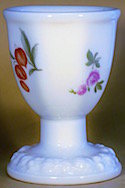
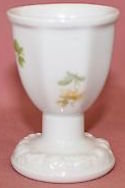
Sommerstrauß ?
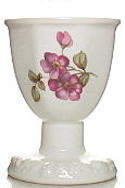
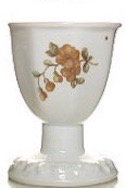
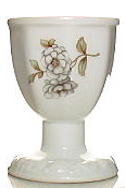
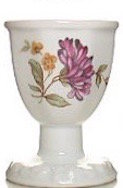
? ?
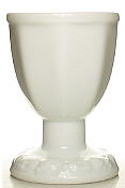

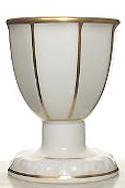
weiß Streublümchen ?
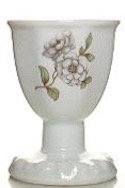
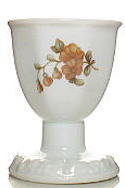
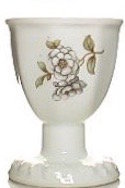

? ?
6 cm high with 5 mm high shaft

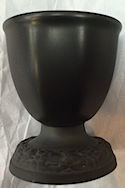
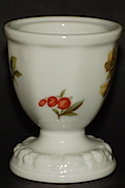
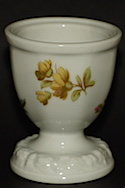
Weiß Schwarz Sommerstrauß
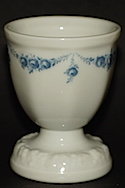
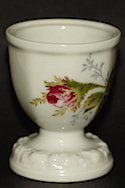
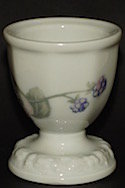
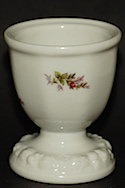
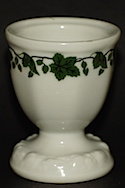
Rosenranke blau ? ? ? Weinlaub
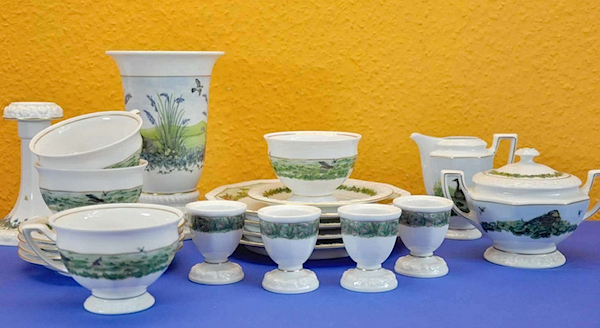
Decor Animal live, 5mm Stand, 6 cm high
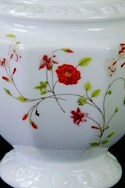

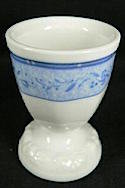
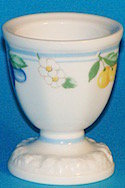
Garden Rustica Sommerflirt Paradies
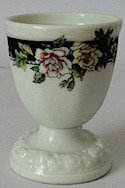

Petersburg St. Germain
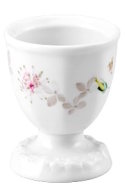
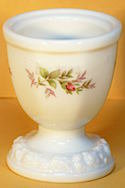
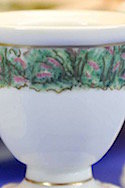
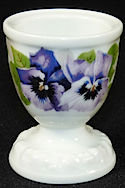
Pink Rose ? Animal Live Stiefmütterchen
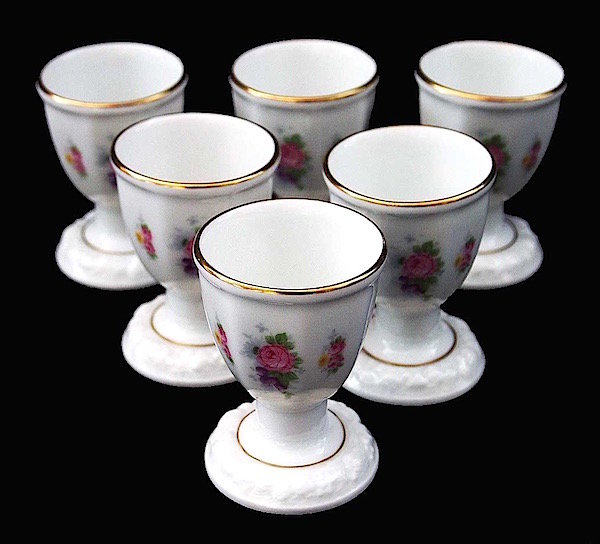
Decor Streublümchen, 10 mm distance, 7 cm high
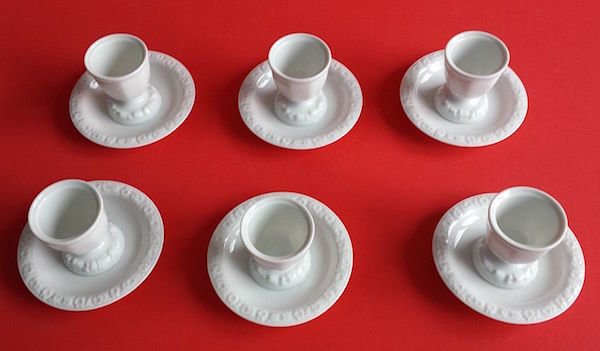
Decor white with solid plate, 5mm Stand*
Photos: Anderson, Diener, Koetsier © Nico Diener, German egg cup museum
Translation: Lesley Kilby
The name "Rosenthal" is a protected by law.
The use here facilitates the exact description of the exhibits and their origin.
August Warnecke – Nordic, Friesian, good
The trading company Warnecke was founded in the 1920s by August Warnecke. The head office was located in the Schnackenburgallee in Hamburg. There are several world-famous foreign factories exclusively represented on the German market. In addition, a new own series with many different patterns such as Ostfriesische Rose (E. Fresian rose) , Ostfriesland (E. Friesland) , Hybiscus, Friesisch Blau (Fresian blue) und Nikko grün (Nikko green) were developed by August Warnecke. These were hand painted over many years. Some designs were later applied using the Steel engraving process. The dishes were prepared in a factory in Japan, exclusively for Warnecke. The old logo is the blue AW-amphora with branches on both sides, but in the 1990s a more modern logo was also used.
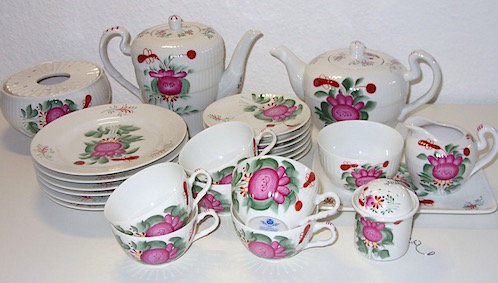
The “Ostfriesland” pattern is the most popular series
and can be found in all traditional East Frisian homes
Production stopped in 1999, since when there have been many imitators and also a Company run by AW (August Warnecke) with products made in Japan and using many Warnecke models and patterns. However, these machine-made dishes lack the charm of the hand-painted small treasures from the House of Warnecke.
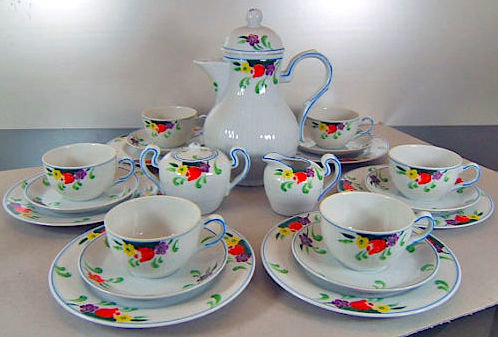
Dekor Tuliptime
In addition to tea and coffee services there are even egg cups, spice and tea caddies, small vases and candlesticks, sugar bowls and all sorts of different confectionery and other dishes, round or square, with or without feet and with or without the perforated pattern on the edge.
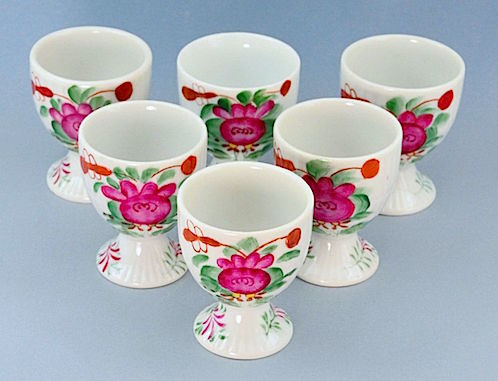




 Frisisch Blue ----- Ostfriesland pattern from various production times ----- Frisia
Frisisch Blue ----- Ostfriesland pattern from various production times ----- Frisia




Hybiscus Füllhorn Ostfrisische Rose ???



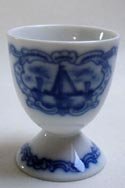
 Leopard Blue Aster Pfingstrose Delfzijl Hamburg
Leopard Blue Aster Pfingstrose Delfzijl Hamburg



Green Distel ????? Tuliptime




 Nikko green Nikko red Nikko blue China Purpur rred China Purpur blue
Nikko green Nikko red Nikko blue China Purpur rred China Purpur blue
Photos: Diener, Koetsier, www © Nico Diener, German egg cup museum
Translation: Lesley Kilby
The name "August Warnecke" is a protected by law. The use here facilitates the exact description of the exhibits and their origin.
Eggcups are also popular with Deruta Ceramics 
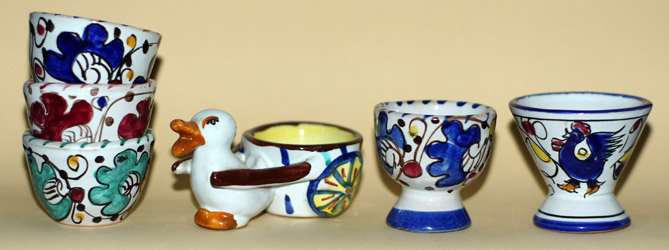
In the small village of Deruta in Umbria, Italy, production of majolica has been operated and maintained for over 800 years. The local companies produce all sorts of ceramics; predominantly handcrafted items that are exclusively hand painted. From there comes the famous rooster pattern in blue, red and green that is frequently wrongly described as coming from Portugal by those lacking expert knowledge.
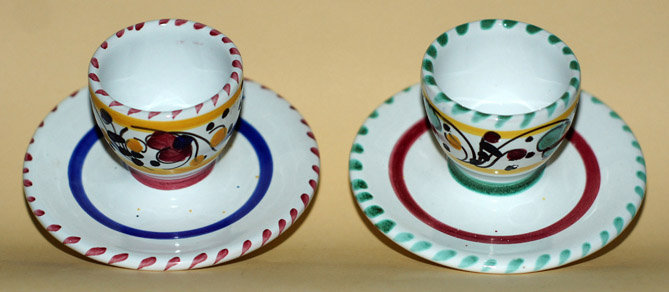
Original eggcups from a pottery in Deruta.
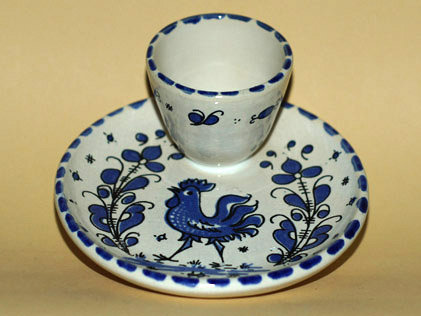
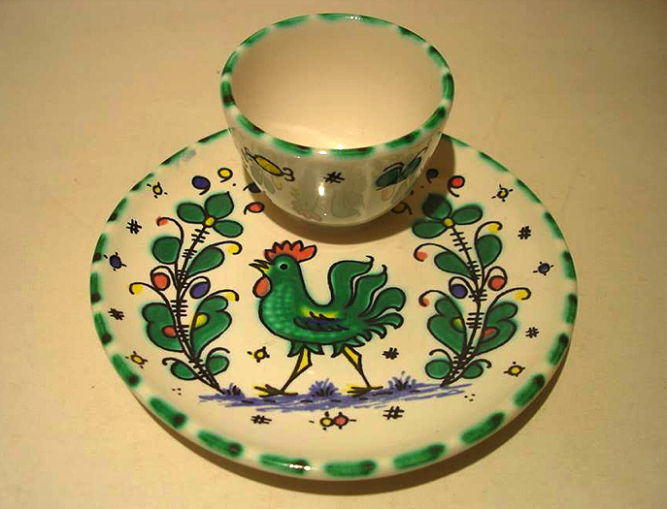
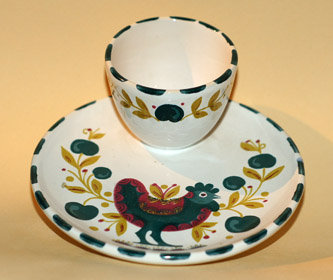
The rooster pattern was so well received that it was often imitated.
Top two Bavarian replicas of Umbrian Decoration with the name "Gallo Verde”
and (Green Rooster) and "Gallo Azul" (blue rooster).
Produced with printed decor with Vogt-Keramik GmbH in Rosenheim.
Beneath this a version of the house of Kocheler Keramik,
Bertram Klein from Kockel am See, also in Bavaria. Hand-painted in faience.
Photos: Diener © Nico Diener, Deutsches Eierbechermuseum
Translation: Lesley Kilby
The name "Vogt-Keramik" and "Kocheler Keramik" arw protected by law. The use here facilitates the exact description of the exhibits and their origin.
»McEgg 2013« by WMF plagiarized - for the second time 
The eggcup by Württembergische Metallwarenfabrik AG, Geislingen in Germany (WMF) and the fake from Dubai resemble one another like peas in a pod. For the second time a foreign manufacturer has shamelessly copied and marketed WMF’s funny eggcup “McEgg”. WMF has already sold over a million copies of the cheerful artisan egg cups for children. Thus a success attracting pirates, even if "McEgg " is a protected trademark.
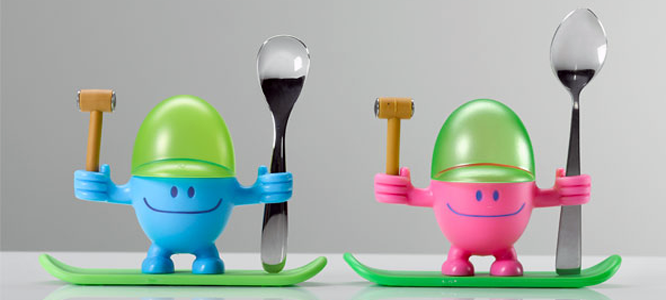
Left Original: WMF AG, Geislingen/Steige, Germany
Right Fake: Distribution: RNA Resources Group Ltd., Dubai
On 15th February 2013, the anti-prize "Plagiarius" (Plagiarism) (a black dwarf with a golden nose) that was launched in 1977 at the consumer goods fair "Ambiente" in Frankfurt / Main (Germany), was awarded for the 37th time. Originals and copies were there on display. Ten blatant, outright cases of plagiarism were "awarded". Piracy should be publicised like this. The cheerful "McEgg" was also there, distributed by the "RNA Resources Group" of Dubai and made somewhere in Asia. In 2003, the same WMF Eggcup was plagiarized before. At that time lawyers of WMF succeeded in having all the illegal, fake copies destroyed.
Photo: WMF © Nico Diener, Deutsches Eierbechermuseum
Translation: Lesley Kilby
The name "WMF" is a protected by law. The use here facilitates the exact description of the exhibits and their origin.
The Good Soldier Schwejk 
The quibbling "Good Soldier Schwejk" is a figure by Jaroslav Hašek, which appeared for the first time in 1911 in a play in Prague. Svejk is a trademark of Bohemia (one of the three countries of the Czech Republic) and therefore it is not surprising that the little fellow has also found his way to a six-piece egg cup series; these are also often used as shot glasses.
The famous porcelain factory, »Haas & Czjzek« from Horní Slavkov (German: Schlaggenwald) made these in the 1960s.
All six scene images of this group are from Jaroslav Hašek's novel 'The Story of the Good Soldier Svejk during World War II.
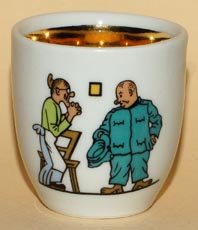
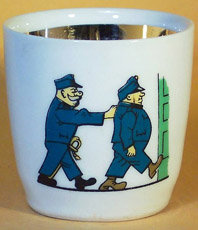
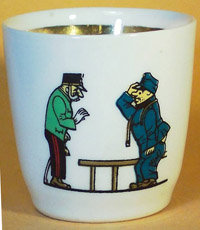
Mrs. Müller and Svejk Svejk arrested Svejk standing to Attention
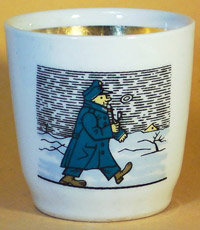
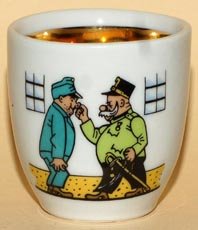
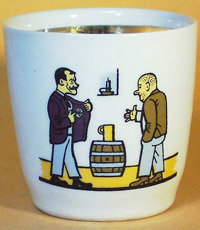
Svejk marches through Svejk with Svejk meets the police- the winter landscape Brigadier von Schwarzenberg spy Brettschneider in Klech
The set has the "H & C Stamp" in blue or gold, with two fir trees, the letter H & C, as well as another "H". The stamp is enclosed with the inscription "MADE IN CZECHSLOVAKIA". A second set of the same design was brought onto the market without stamps.


The most common form with stamp Rarer form without stamp
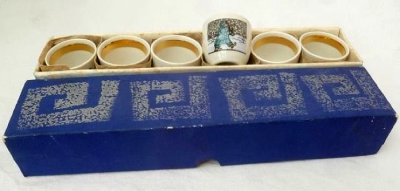
Original Packaging
Svejk (Švejk Czech) is a typical Prague character, who battles through life with guile and wit and tries to be a soldier to dodge the war effort. Through his behaviour and mischievous expression, he criticised the futility of war and thus the logic of friend and foe. In Nazi Germany, Hašek's novel 'The Good Soldier Schweik "(original title »The story of the Good Soldier Svejk during the World War«) was on the so-called" »Black List« and thus belonged to the burnt books whose possession was a criminal offence.
Bertolt Brecht was so impressed by the figure of Svejk that he wrote the play »Schweyk in the Secount World War« in 1942 whilst in exile in the US. Nazis take the place of domination by »the House of Habsburg« the and W.W.ll replaces W.W.l. The play is written by Bertolt Brecht in the style of epic theatre and was premiered in Warsaw 1957.
Haas & Czjzek also brought out other eggcups in similar form e.g. these two with scenes of Prague.


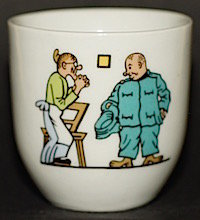
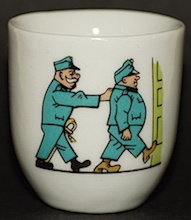
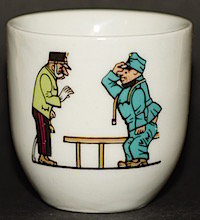
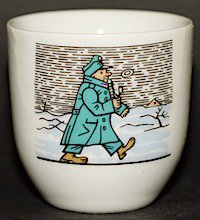
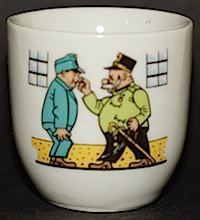
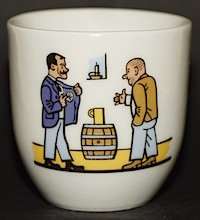
From the 1990s the Czech Porcelain factory “Thuny” in Karlovy (formerly Karlsbad) brought out the same series. This is hard to distinguish from the original series. The Karlsbad ones only left out the gold line on the inside. “Thuny, Czechoslovakia” is often confused with the manufacturers Thun from Bozen in Northern Italy. Both are however completely separate companies. |
Photos: Anderson, Diener © Nico Diener, Deutsches Eierbechermuseum
Translation: Lesley Kilby
The name "Haas & Czjzek" and "Thuny" is a protected by law. The use here facilitates the exact description of the exhibits and their origin.
Betty Boop Text in German
is a cartoon character from the Max Fleischer cartoons that have been continued to be produced after the takeover and subsequent bankruptcy of Fleischer Studios part of Paramount Studios. The first animated films were made in 1930 in the Talkartoon series. Later followed an own Betty Boop series. As her name sounds (boop/boob), the hallmark of Betty Boop is her sex appeal.
With a short skirt, garter and curly Bob she embodies the Flapper Girl of the Roaring Twenties. Typical of this type of woman she was dressed to thrill, loved to celebrate and dance. Betty Boop was the first female cartoon character with their own sexuality. Other female cartoon characters such as Minnie Mouse were virtually represented as sexless beings. The Betty Boop-cartoons are full of sexual innuendo. So there is hardly a cartoon, where she does not need to hitch up her slipping garter or unsuccessfully hold down her billowing skirt. Due to the great popularity of these cartoons, it is not surprising that Betty Bob has also found her way onto egg cups. The first specimen, shown below, is from the collection of Ad Koetsier from the Netherlands and the other two examples are from the collection of Nels Anderson from Luissiana.
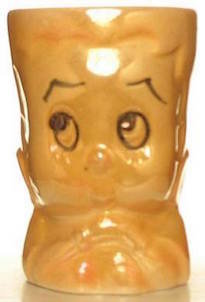
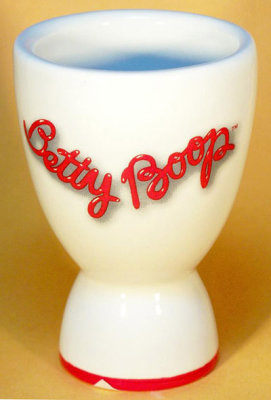
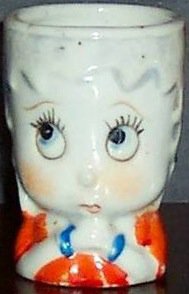
Photos: Anderson © Nico Diener, Deutsches Eierbechermuseum
Translation: Lesley Kilby
The name "Betty Boop" is a protected by law. The use here facilitates the exact description of the exhibits and their origin.
Chicken and Rooster Text in German
Scenes from the farm such as chickens, roosters and chicks are a very popular motif for eggcups and are very popular all over the world with collectors. No wonder - no chicken, no egg and no egg, no egg cups...
Here we will deal with eggcups with chicken and rooster motifs and show a sample of an almost infinite variety of this subject, which began with the first “Chicken Egg Cup” made by the Schumann factory, Moabit in Germany in 1835.
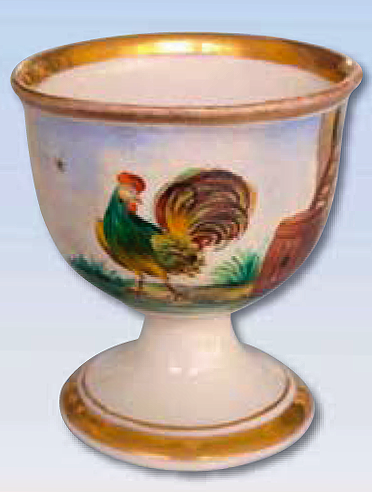
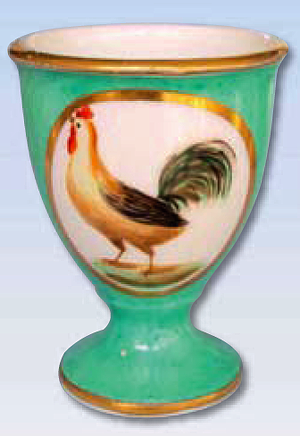
Hand-painted rooster, Hand-painted rooster in Reserve,
Schumann Moabit 1835 - 1837 Limoges 1870 - 1900
At that time, the renowned porcelain manufactures were not really giving any attention to the chicken / rooster decoration, since it was not easily adaptable to a classic dinnerware. That was much easier done by decorating dinnerware with little flower, fruit or fantasy patterns. On the other hand chicken fit much better on dinnerware than protected songbirds, Chinese dragons or windmills. It was only the private porcelain factories of the Gründer-period such F. A. Schumann in Moabit, Germany, Tressemanes & Vogt in Limoges, France, Philip Rosenthal in Selb, Germany and Thomas in Marktredwitz, Germany who finally gave the chicken the honor to be represented on an eggcup and thus paved the way for the triumph of the “Chicken on the Cup”, which flourished during the Art Nouveau and Art Deco period and continues to this day.
Décor images whether in form of decals or transfer templates were often purchased and used by various manufactures. That is why many eggcups look apparently so similar. Here an example.
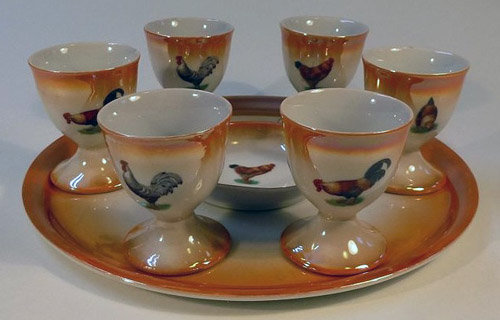
Ensemble with different motifs by Josef Rieber, Selb (Germany) from around 1920.
Transfer printed image, framed with airbrush patterns and luster glaze.
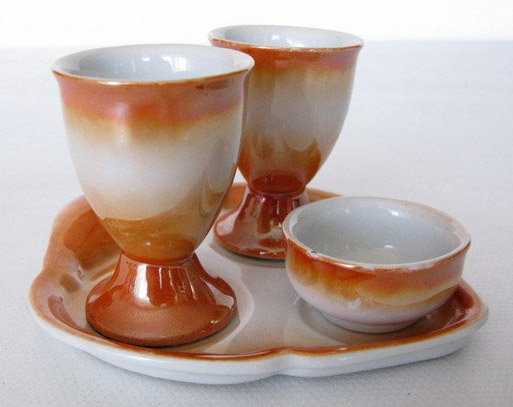
Similar design with lustre glaze, but or image.
Manufacturer unknown.
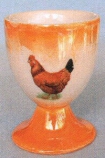
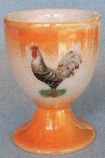
Two art nouveau cups by Julius Rother,
Mitterteich (Germany) from 1905.
Again with transfer printed image,
framed with airbrush patterns and luster glaze.
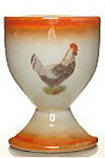
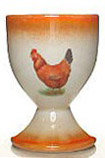
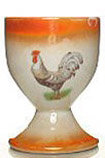
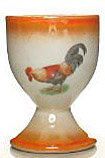
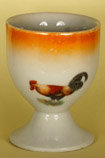
Eggcups from factorys in Thuringia (Germany) from around 1930.
Again with transfer printed image, framed with airbrush patterns and luster glaze.
It is evident that one copied from the other. The use of airbrush patterns and luster glaze are techniques that require very skillful craftsmanship. It is even more regrettable that some manufacturers apparently lacked own ideas or simply copied lucrative series by other factories.
Chicken motifs are rarely seen on eggcups by English factories, which certainly has a reason, which could not so far not be unraveled by the author.
In Germany the most famous “Chicken Eggcup” is hand-painted, from the series "Rooster and Chicken" by the Zeller Ceramics Factory from Zell am Harmersbach, Germany. Designed in 1898 by Karl Schöner the popular pattern has become a cult and to this day, even far beyond the borders of Germany, it is attractive for young and old.
Schöners Rooster, for more than 110 years almost unchanged
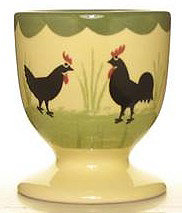
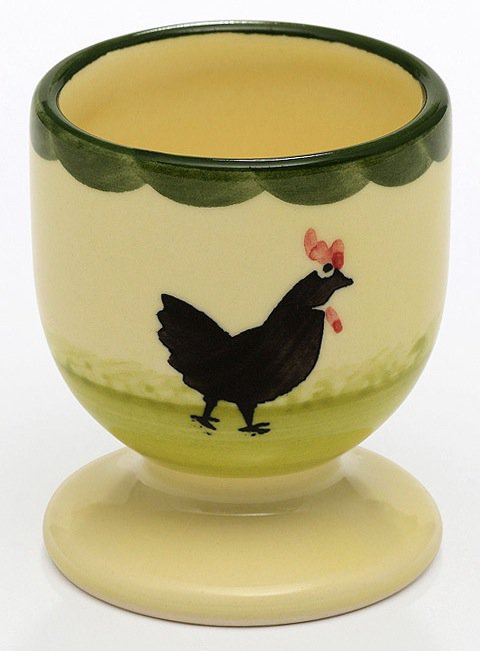
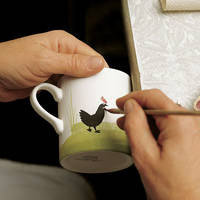
18?? - 19?? 18?? - today Manufacturing exclusively
in handmade
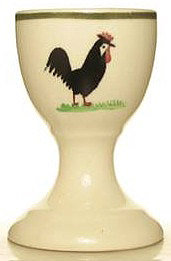
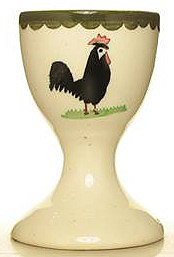
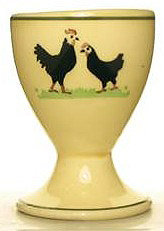
18?? - 19?? 18?? - 19?? 18?? - 19??
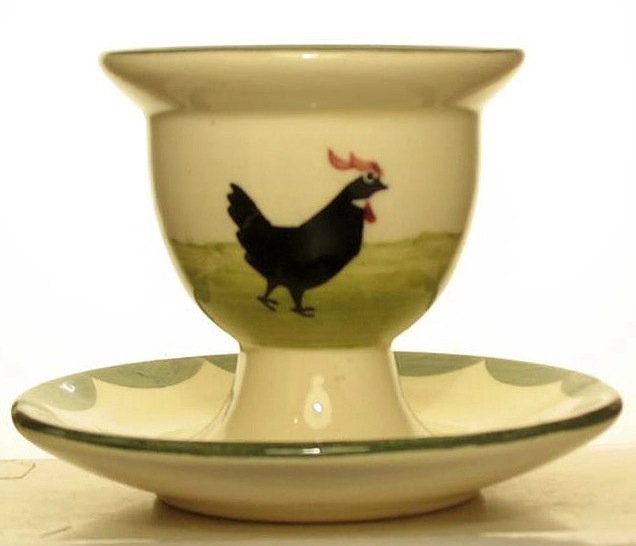

Version with fixed plate 19?? - 19?? and 19?? - 19??
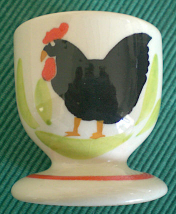
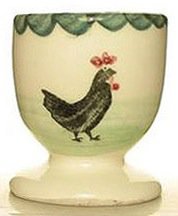
Plagiarism or spezialdecor? Cheap plagiarism from Taiwan
Since most "Chicken Eggcups" are not marked, they can be assigned only with difficulty to a factory. We still would like to try and ask all our readers to help with that task.
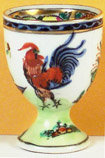
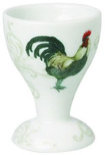
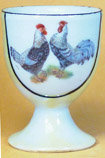
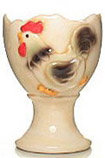
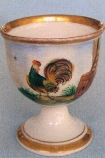
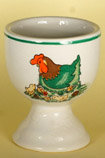
China "Mr. Rooster" Deutschland 4 ? F.A. Schumann (D) 6 ?
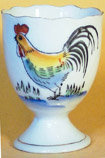
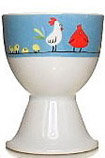
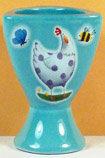
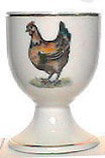
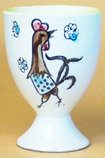
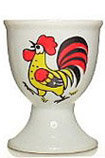
7 ? 8 ? 9 ? Beyer & Bock (D) Japan Japan
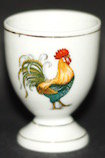
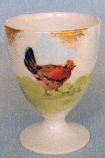
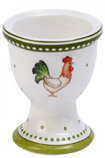
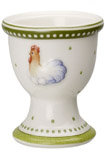
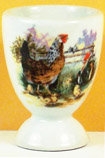
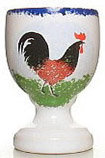
(F) (Quimper Stil) T.&Vogt, Limoges (F) Villeroy & Boch, Farmers Spring England 18 ?
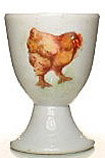
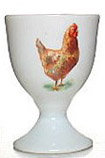
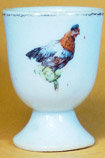
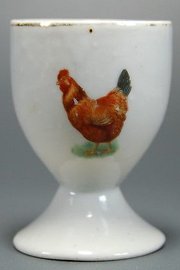
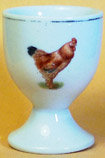
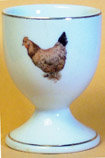
19 ? 20 ? Josef Rieber (D) Josef Rieber (D) Josef Rieber (D) 24 ?
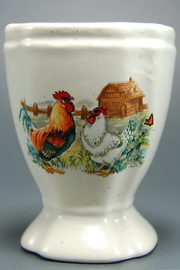
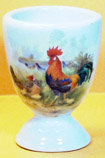
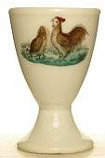
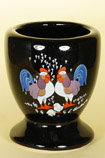
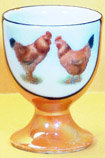
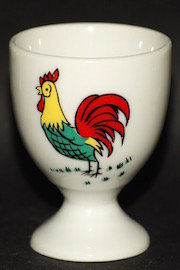
25 ? 26 ? 27 ? 28 ? Deutschland Terpa
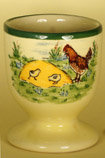
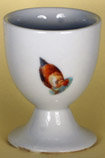

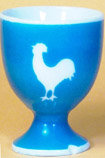
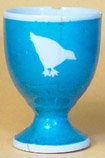
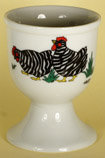
Zeller Keramik (D) 32 ? 33 ? 34 ? 35 ? 36 ?
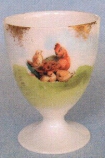
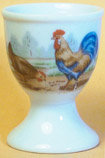
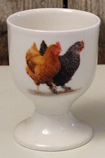
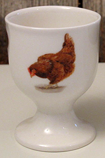
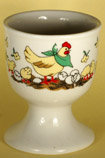
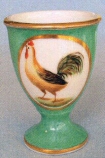
Tressm.&Vogt (D) 38 ? Leonardo Collection, Farmyard England Limoges 1870-00
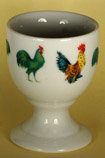




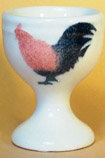
43 ? 44 ? 45 ? 46 ? 47 ? 48 ?
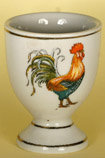
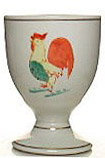
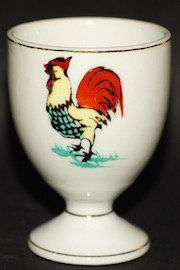
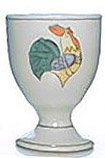
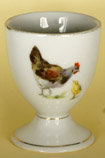
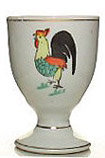
China China China China China China

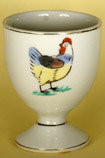
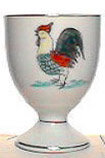
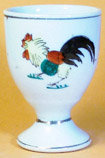
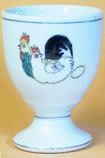
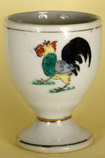
China China China China China China
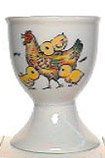
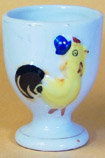
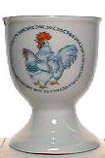
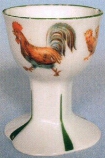
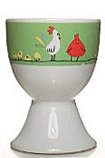
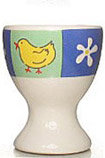 61 ? 62 ? 63 ? Rosenthal (D) 1905 65 ? 66 ?
61 ? 62 ? 63 ? Rosenthal (D) 1905 65 ? 66 ?
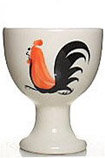
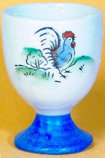
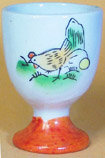
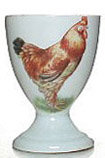
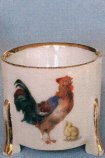
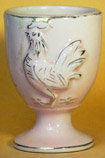
67 ? Japan Japan 70 ? Thomas (D) Japan (rot)
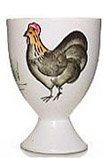
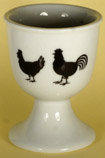
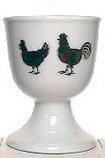
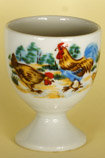

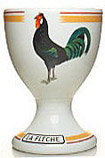
Japan 74 ? 75 ? Japan 77 ? Rörstrand (S)
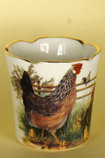
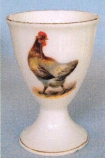
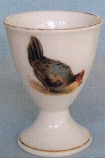
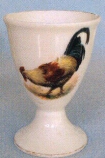
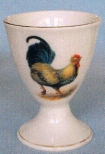
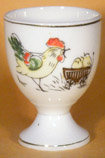 England Rosenthal (D) Rosenthal (D) Rosenthal (D) Rosenthal (D) Japan
England Rosenthal (D) Rosenthal (D) Rosenthal (D) Rosenthal (D) Japan
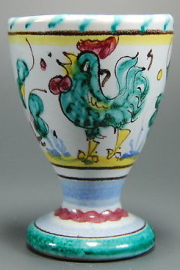

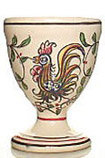
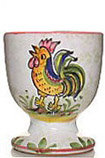
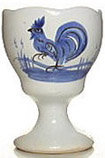
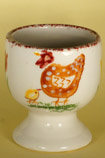
Deruta (I) Portugal Portugal 88 ? Quimper (F) 90 ?
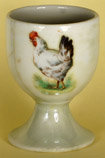
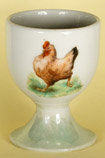
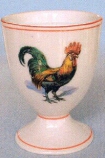
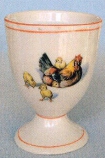
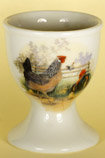
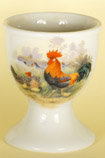
Beyer & Bock, Thüringen (D) Metzler&Ortloff, Ilmenau (D) um 1920 Interpresent KJ (D)
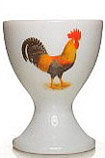
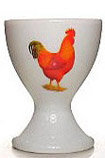
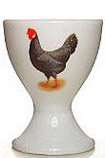
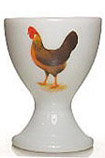

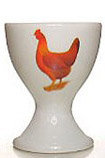
Djem (NL) Djem (NL) Djem (NL) Djem (NL) Djem (NL) Djem (NL)
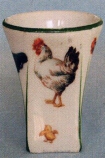
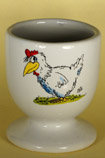
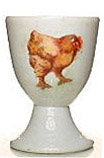
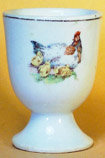
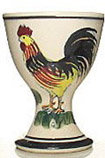
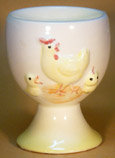
Böhmen (CSR) Zeller Uli Stein (D) 105 ? 106 ? 107 ? 108 ?
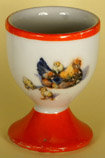
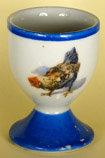
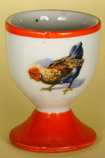
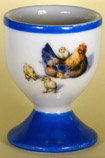
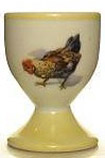
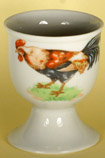
Thüringen (D) Thüringen (D) Thüringen (D) Thüringen (D) Thüringen (D) Japan
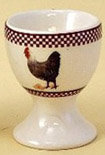
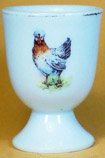
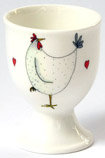
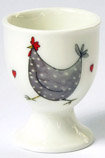
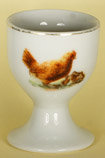
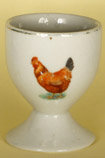
aus Dolomit (I) 116 ? TheSkinnyCardCompany (GB) 119 ? 120 ?
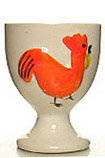

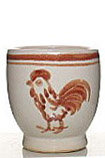
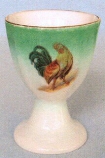
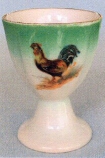
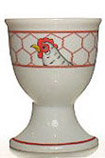
121 ? 122 ? 123 ? Schomburg&Söhne, Rosslau, (D) um 1920 126 ?

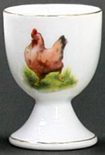
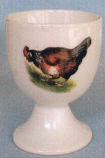
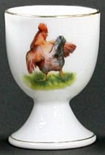
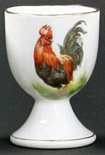
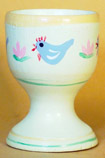
127 ? ----- Beyer & Bock, Volkstedt (D) um 1910 ------ 132 ?
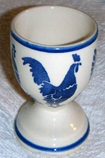
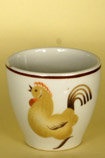

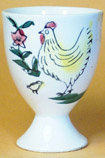
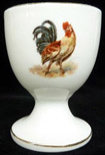

Emma Bridgewater Arabia, SF 135 ? Japan 137 ? Beyer & Bock (D) Blue Hen (GB)






Nympfenburg --- Frankreich --- 142 ? 143 ? 144 ?






145 ? 146 ? 147 ? 148 ? 149 ? 150 ?






151 ? 152 ? 153 ? 154 ? 155 ? Rumänien


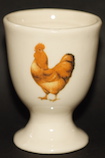



157 ? 158 ? 159? 160? 161? China
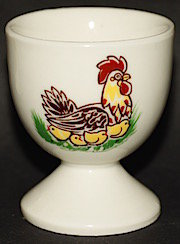
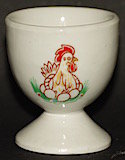
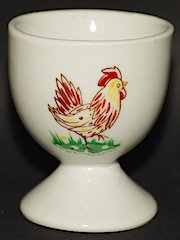

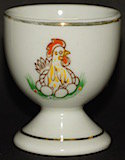
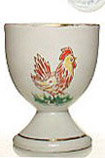
---- VEB Kahla, Thüringen ----
Photos: Anderson, Koetsier, Diener, Köneke, Haak, Zeller Keramik et al © Nico Diener, Deutsches Eierbechermuseum
Translation: Dr. Anna de Vincenz
The name "Beyer & Bock", "Bridgewater", "Metzler&Ortloff", "Rörstrand", "Rosenthal", "Rosslau", "Schomburg & Söhne" and "Zeller Keramik" arw protected by law. The use here facilitates the exact description of the exhibits and their origin.
Popeye is a comic and cartoon character by the American cartoonist Elzie Crisler Segar. In over 80 years of his existence the fight-loving sailor and his girlfriend "Olive Oyl" gained worldwide fame. Exceptions are later media such as films and computer games as well as the music.
Popeye’s permanent trademark, spinach, was introduced in the cartoons. He swallowed it by the whole canful, to develop unimagined powers for his countless brawls. Popeye’s love of spinach was based on the former opinion that considers this vegetable to be an ideal tonic because of its allegedly high iron content. However, the exceptionally high iron content was based on a fatal miscalculation of the Swiss physiologist Gustav von Bunge. A study published in 2012 by the Swedish Karolinska Institute comes to the conclusion, that the nitrates rather than the iron contained in spinach can promote the growth of muscles, especially those for endurance.
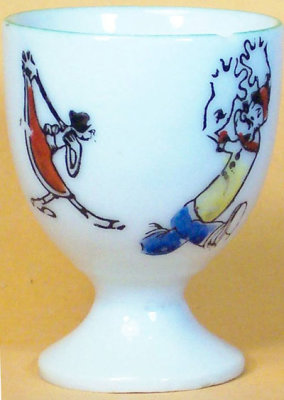
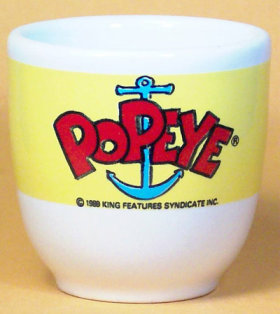
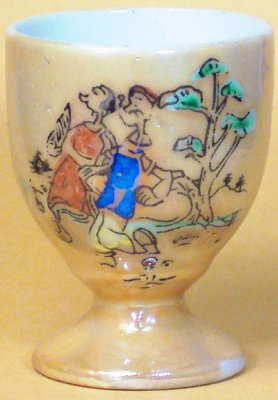
Olive Oyl und Popeye Olive Oyl und Popeye
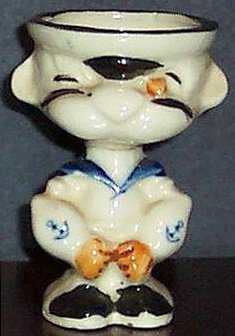
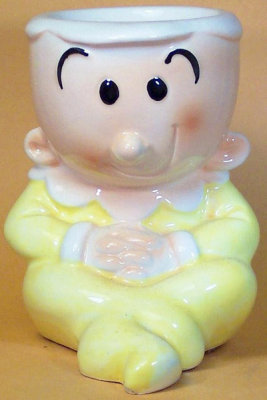
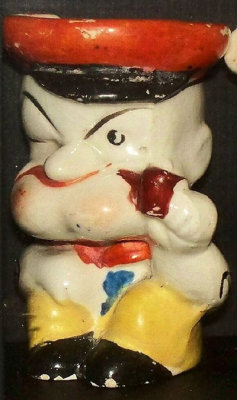
Popeye Olive Oyl Popeye
Photos: Anderson © Nico Diener, Deutsches Eierbechermuseum
Translation: Lesley Kilby
The name "Popeye" and "Olive Oyl" arw protected by law. The use here facilitates the exact description of the exhibits and their origin.
Kahla – children’s designs 
Here is a picture collection of unique egg cups with children’s designs from the former VEB Feinkeramik in Kahla / Thüringen (today Kahla Porzellan GmbH). These beautiful pieces were produced in large quantities, mainly for export. The East German economy desperately needed foreign currency, so many products were produced for export only to the West. From the proceeds, goods such as raw materials and medicines were purchased. Thus, the VEB Feinkeramik Kahla has made its contribution to public health. For this reason, these egg cups a real piece of history.
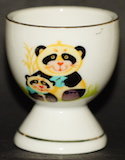
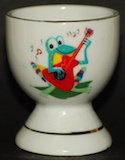
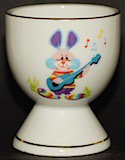
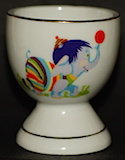
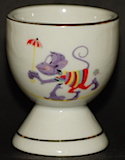
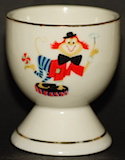
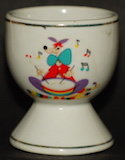
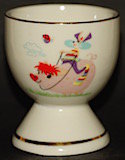
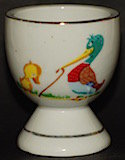
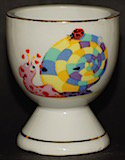
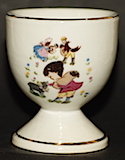
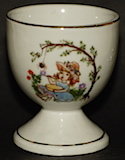
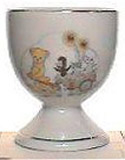
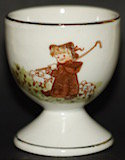
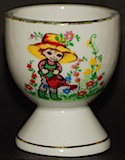
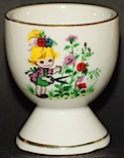
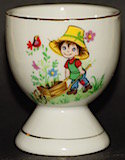
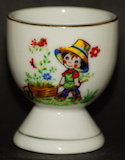
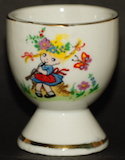
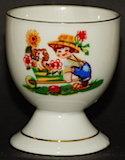
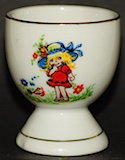
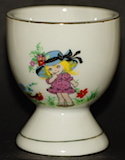
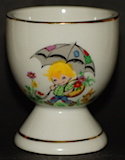
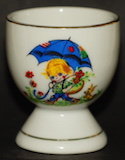
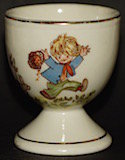
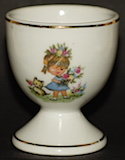
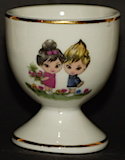
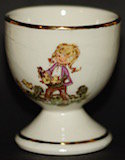
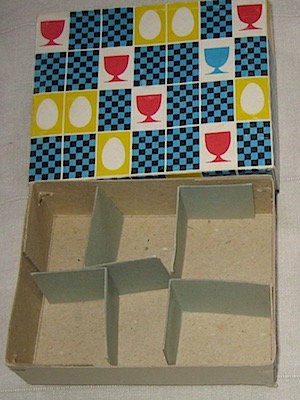
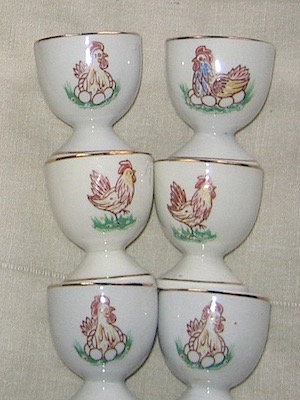
VEB Kahla, Original Packaging



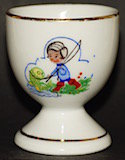
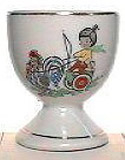
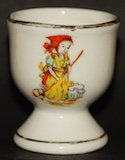
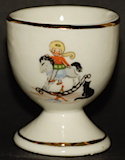
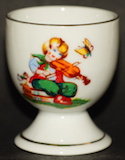
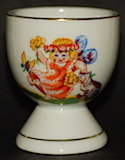

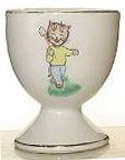
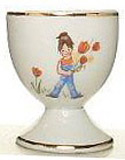
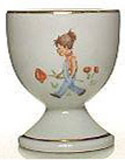
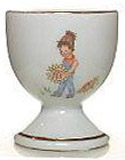
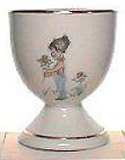
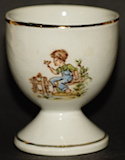
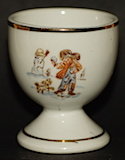
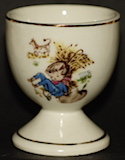
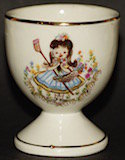
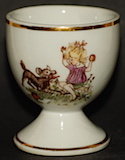
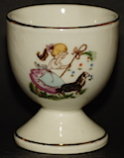
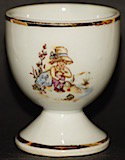
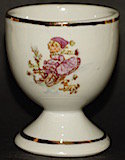
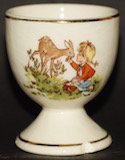
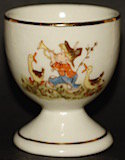
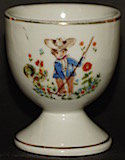
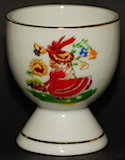
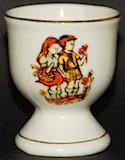
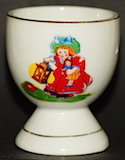
without gold rim



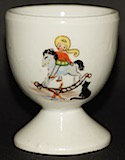
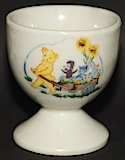
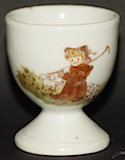
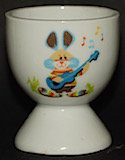
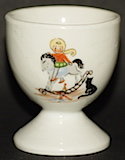
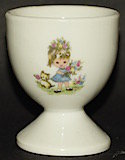
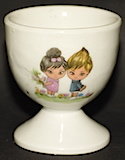
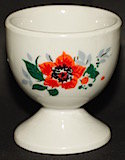
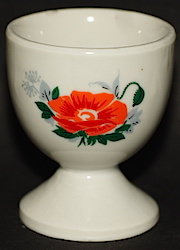
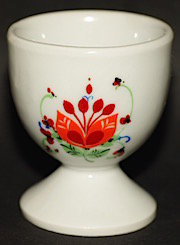

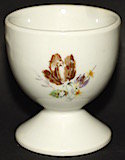
The total number of designs, as well as a precise date cannot be determined exactly according to our current knowledge.
Photos: Koetsier, Diener © Nico Diener, Deutsches Eierbechermuseum
Translation: Lesley Kilby
The name "Kahla Porzellan GmbH" is a protected by law. The use here facilitates the exact description of the exhibits and their origin.
Every child in England knows about Basil Brush, the little red fox with the big bushy tail, who is the subject of an afternoon Television series. Basil has been represented in egg cups by an unidentified plastic figural cup, and then on a china cup from Coalport. The cups come from the collection of member Nels Anderson, who lives in the state of Louisiana, in the US. |
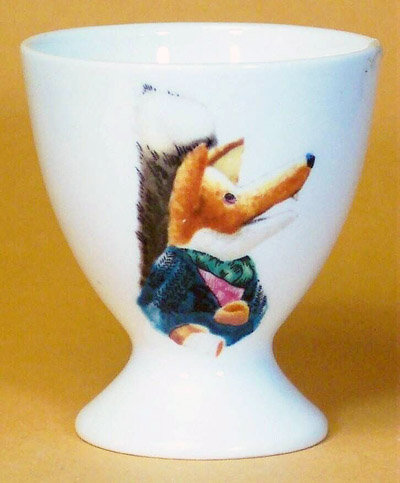
Photos: Anderson © Nico Diener, Deutsches Eierbechermuseum
Translation: Lesley Kilby
The name "Basil Brush" is a protected by law. The use here facilitates the exact description of the exhibits and their origin.
The Swedish company Sagaform is one of the leading top brands for Scandinavian design. Playful, innovative products for the kitchen and the table are the majority of Sagaforms’ collection. And of course eggcups cannot be missing among these.
All products captivate with their typical design, and are partly the result of the cooperation with well-known Swedish designers like Jon Eliason, Camilla Engdahl, Gustav Hallén, Lovisa Wattman, Matz Borgström and Ylva Olsson.
In addition to egg cups in various shapes, these »long-necks« are the most famous, due to their impressive shape and rich color palette.
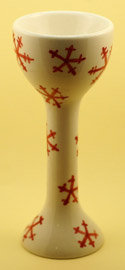
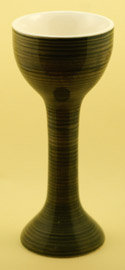
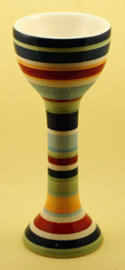
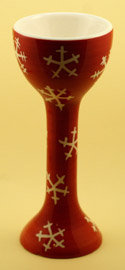
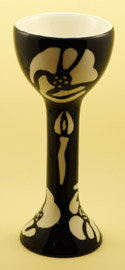
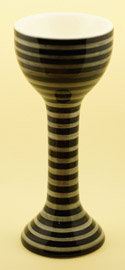
Photos: Diener © Nico Diener, Deutsches Eierbechermuseum
Translation: Dr. Anna de Vincenz
The name "Sagaform" is a protected by law. The use here facilitates the exact description of the exhibits and their origin.
The painter and poet Ole Winther created a series of enchanted motives for the Hutschenreuther brand, which was bought up by Rosenthal in the year 2000, such as these month-eggcups. He studied ancient porcelain on many art exhibitions and developed his idiosyncratic style. Since 1978, one can find his motifs with its unique décor on collectors’ dishes and Christmas items.
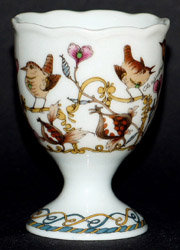
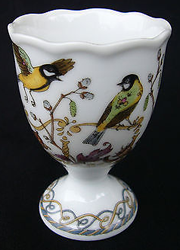


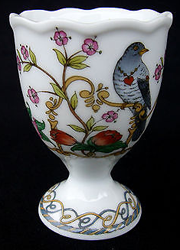
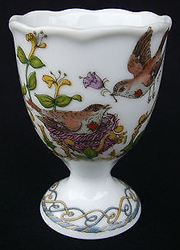 Januar Februar März April Mai Juni
Januar Februar März April Mai Juni
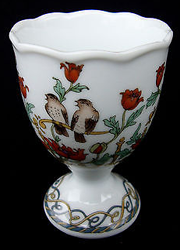
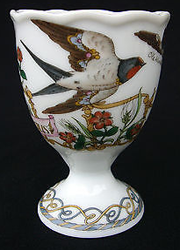
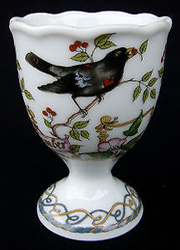
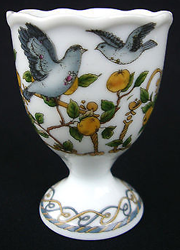
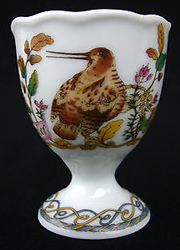
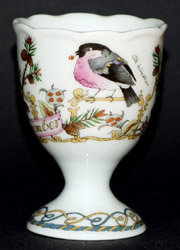 Juli August September Oktober November Dezember
Juli August September Oktober November Dezember
Photos: Diener © Nico Diener, Deutsches Eierbechermuseum
Translation: Lesley Kilby
The name "Hutschenreuther" and "Rosenthal" arw protected by law. The use here facilitates the exact description of the exhibits and their origin.
Visit to the Gladstone Pottery Museum, Stoke-on-Trent 
A large part of English porcelain is produced in Stoke-on-Trent. This town in the W. Midlands is actually comprised of several small towns, also called “the Potteries”. In its heyday, there were up to 4,000 potteries that sold their wares to the whole world. Today, most of these potteries have disappeared and those that are still in existence are working under umbrella companies like Royal Doulton, Spode, Wedgwood and Minton. The first photo shows Stoke a long time ago when thousands of bottle-kilns were busy firing ceramics. The second photo shows one of the 46 bottle kilns in Stoke that is still in existence. These kilns get their name from the bottle-shape of the brick building.
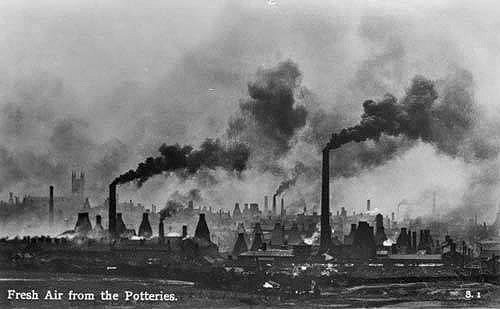
A visit to the Gladstone Pottery Museum is a great way of understanding Stoke-on-Trent’s history of pottery. I first went there in the 90s and at that time there were still a number of smaller potteries. There was a bus painted in the »Blue Willow Design« that went from the station to Barlaston, the most southerly of the pottery towns. Along the way the bus stopped at several small potteries, many of which I visited. On my second visit at the end of the 90s, I was horrified to see that a new North/South motorway had been built causing many small potteries to close. The new bus route only had a few stops and these were mainly at the gates of the larger Potteries.
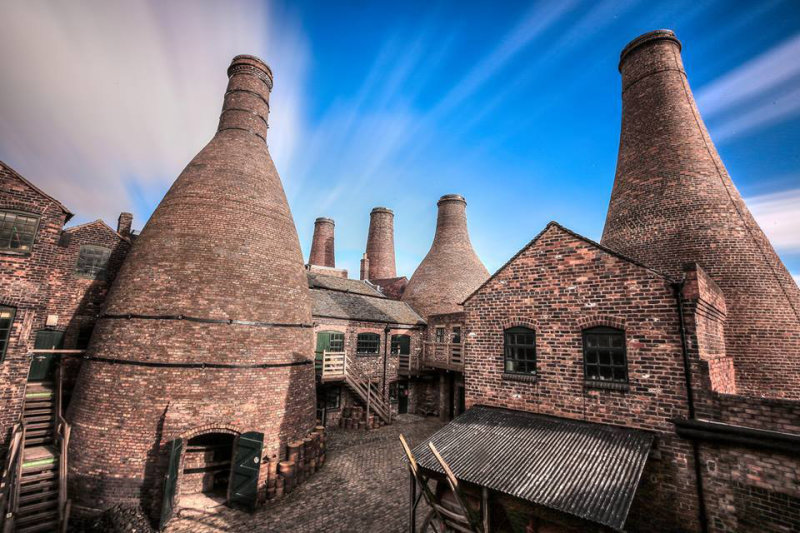
Gladstone Pottery Museum was awarded the “Visit England Quality Rose Marque” and also received “Small Visitor Attraction” at the Staffordshire Tourism awards. It is always worth a visit and you can buy lovely things at reasonable prices in the Pottery shops that are still there. Stoke-on-Trent is easily reached by train from London and is suitable for a day trip.
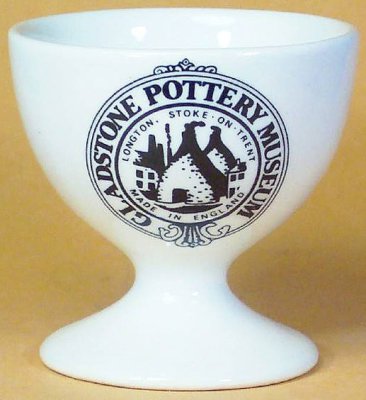
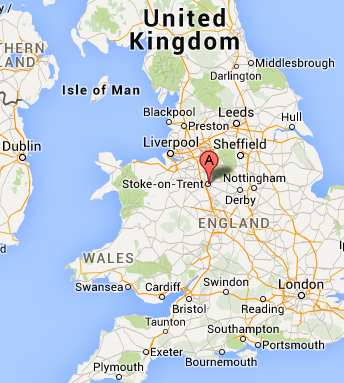
I bought this egg Cup in the Museum Stoke-on-Trent is easy to reach of London
Photos: Anderson and Gladstone Potty Museum © Nico Diener, Deutsches Eierbechermuseum
Translation: Dr. Anna de Vincenz and Lesley Kilby
The name "Royal Doulton, "Spode", "Wedgwood"" and "Minton" arw protected by law. The use here facilitates the exact description of the exhibits and their origin.
The grocery chain “Kaiser’s” (formerly Kaiser’s Coffee, that now belongs to the Tengelmann group) was already one step ahead of the competition in 1905. To increase its customer base it introduces a system of savings stamps. With every purchase you received 5% discount in savings stamps that were stuck in a savings book. Every complete book was worth 1RM against the purchase of goods in store. From 1920 to the start of the 1930’s there was crockery in this style. There was a complete 36 piece coffee and dinner service. This was not available in the shops. Stylistically, it clearly belongs to the Art-deco movement. |
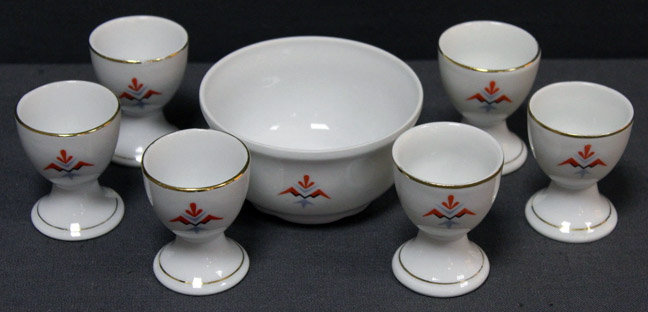
The egg cups in this pattern were made exclusively for Kaiser’s by the Bavarian manufacturer Schaller & Co (later Winterling) in Windischeschenbach. The crockery mostly had the manufacturer’s mark “Bavaria”.
above: an example from the de Vincenz Collection | It is uncertain which story lies behind the example (left). It is probably a reject that has somehow found its way to a customer.
|
Photos: Siebert, Diener et al © Nico Diener, Deutsches Eierbechermuseum
Translation: Lesley Kilby
The name "Kaiser's" is a protected by law. The use here facilitates the exact description of the exhibits and their origin.
Graveart 
This egg cup is a piece of “Graveart”, more commonly called “Trenchart”, as they were often made in the long lulls between fighting during WW1. In the picture you can see soldiers making decorative articles from grenade cases for their relatives back home. These rare egg cups are made from parts of a former French honeycomb lighter from 1914-18.

Photos: Siebert et al © Nico Diener, Deutsches Eierbechermuseum
Translation: Lesley Kilby
Speedy and friends – collection 
As there is no informative page in the whole www, I have listed all the models and put together some interesting facts.
The printable list of all speedys
In 1998, when the first Speedy appeared, no one would have guessed what a success story was in progress. The company Casablanca GmbH & Co. Kg from Bochold produced and marketed this cheeky troop of 119 different egg cups for 12 years.
The first model, “Speedy the original”, portrayed half an eggshell on duck feet and was manufactured from food safe polymer material. The designers of Casablanca introduced themselves with the development of the good humoured characters on a well-laid breakfast table. Morning starts with the smell of fresh bread and coffee, a good tune on the radio and a perfectly boiled egg for breakfast, served in a humorous egg cup.
After the first six models were on the market, there was a loud call to design further characters and create a whole series for collectors. Different occasions, professions, hobbies, sport, fitness etc. were the foundations of the various models.
A few Speedys were produced as limited editions. According to the statement by Casablanca, the manufacturing tools were destroyed after the production to stop any later copies being made.
The manufacture of the Speedy egg cups included hand crafting. They were produced in 11 different stages and hand painted.
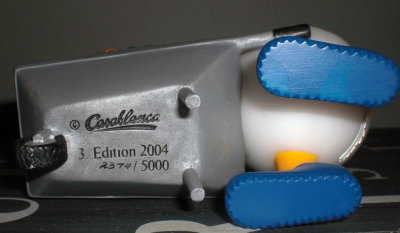
The successful sale of several million items was the decisive factor for the varied fakes and forgeries on the market. In 2005 the Taiwanese manufacturer “Rosco International” was awarded the feared “anti-prize Plagiarius” (for the most flagrant imitation). They did not shy away from immediately forging 6 egg cups, true in almost every detail, and distributed them in Germany through “Mode und Preis” the subsidiary of KarstadtQuelle.
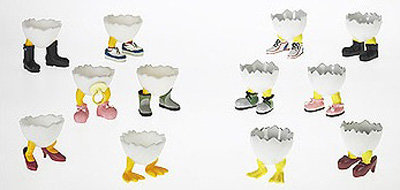
left 6 originals of Casablanca, right 6 plagiarism of Rosco International
In the forgery museum in Solingen you can still see the original and the fakes. Originally a Speedy egg cup would have cost 5-8 Euros – today you might have to lay out 100 Euros to get a specific model.
Here are two more examples:
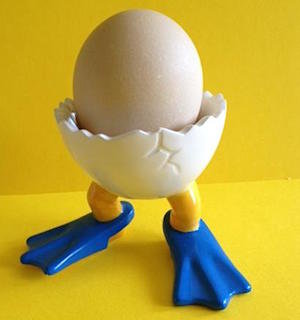
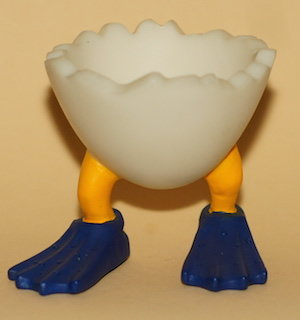
Plagiat Original

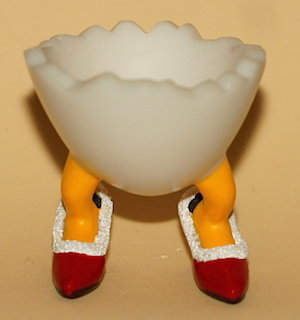
Plagiat Original
Photos: Siebert, Diener, Le Favre et al © Nico Diener, Deutsches Eierbechermuseum
Translation: Lesley Kilby
The name "Casablanca GmbH & Co. Kg" is a protected by law. The use here facilitates the exact description of the exhibits and their origin.
Exhibition-Eggcup »Festival of Britain 1951« 
As early as 1947 we discussed in my small hometown Wath-upon-Dearne (South Yorkshire, England) the organization of our contribution to the »Festival of Britain - 1951«. The Urban District Council was thinking, how the community could participate in the exhibition and decided to have an eggcup created and produced. It should be made of glass and manufactured by the local company »Waterstone Glassware Ltd.«. The approved design created by T. Taylor Seago, a Director of Waterstone Glassware Ltd., showed the exhibition logo with the words »Festival of Britain« around the upper edge and «Wath upon Dearne» at the bottom of the foot on the blue glass.

At first 5000 eggcups of that type were sold to the city at cost price of 6 pence per piece. By the middle of the year 1951 the eggcups became so popular that all 5000 pieces were sold. After that it was decided to change the color to pink and more were produced. Later they were also produced in green.
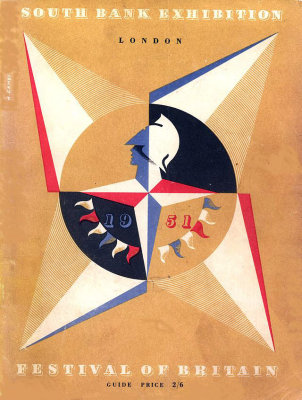
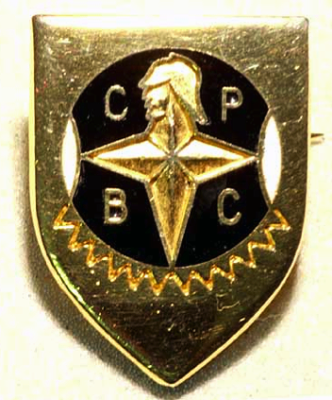
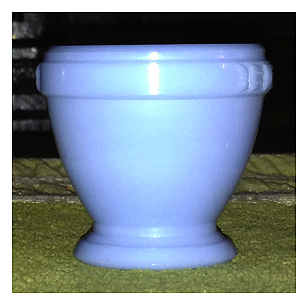
Exhibition Poster Official Exhibition Coat Version Without Exhibition Logo
At some point blue versions without exhibition logo have surfaced. It is not clear whether they existed already before the exhibition or if they were produced as a result of the big selling success. It is, however certain, that they were also produced by »Waterstone Glassware Ltd.«.
Translation: Dr. Anna de Vincenz
An Ugly Duckling changes into a Swam 
In UK it is illegal to sell “silver’ unless it is correctly marked as such by an assay office. All other items must be sold as “White Metal” – which could mean anything.
Some years ago I bought for a few pence a “White Metal” egg cup :-
It was quite pretty and looked nice when polished and it stood in my collecting for some time. It had a long indentation in the bottom and I assume it was once part of a tray of multiple egg cups and spoons. An ugly duckling, but I liked it
During a cleaning I was trying to clean the inside of the indentation and it was clear that there was a tiny mark inside. It was too small to be readable but did not have the form of a UK silver mark. A little later I looked at it with a microscope and this is what I saw :-
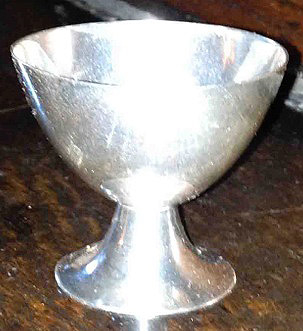
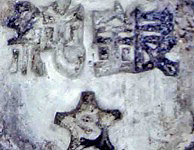
It was a tiny Japanese silver mark used 1868-1912! My ugly duckling had turned into a swan – and I loved it even more
The moral is that we should always look for marks on our cups, and if we find them a little research is worth the effort, if only to learn a little more about our treasures even if they are not swans.
Photos: Llewellyn-Edwards et al © Dr. Tam Llewellyn-Edwards
Translation: Lesley Kilby
Sue Whimster, the textile designer, has created a small, private pottery in a London suburb. For years she has been making small, indiviual clay treasures in a former conservatory on the back of her house. Among these are dogs, cats, foxes, wild boar, wolves and decorative items for the home and garden. Obviously arty egg cups are also included in this list. |
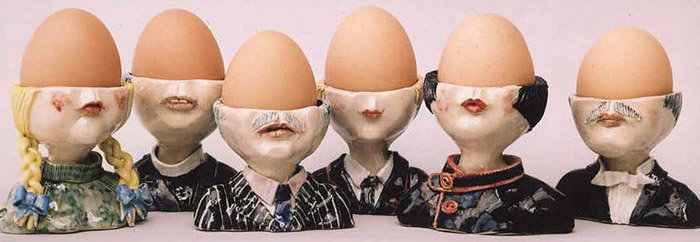

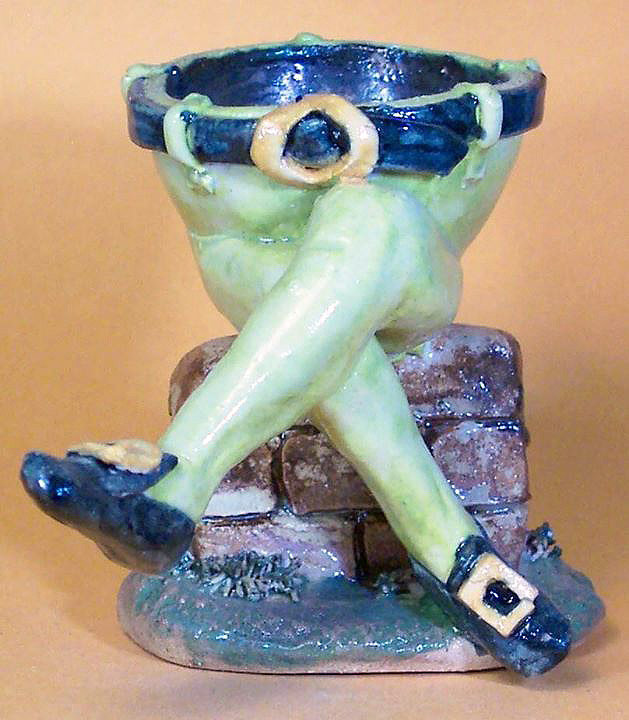
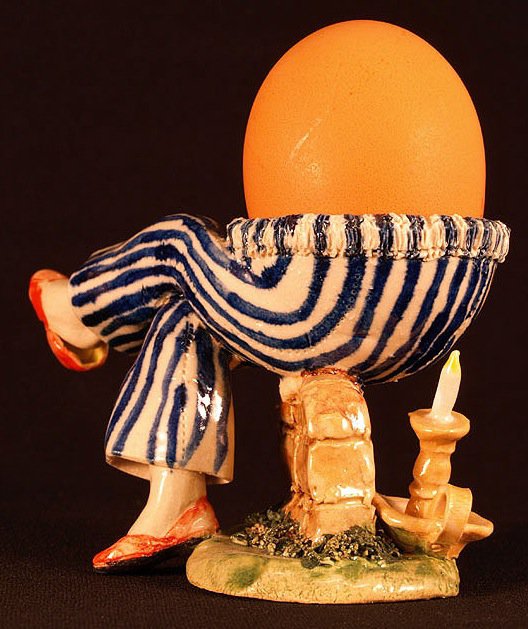
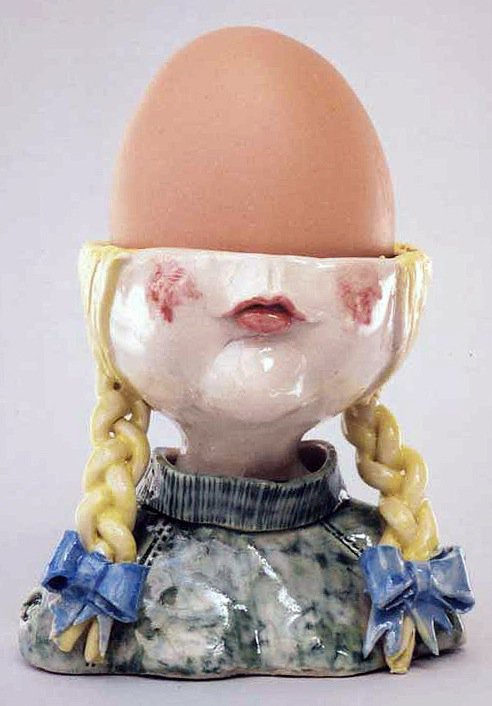
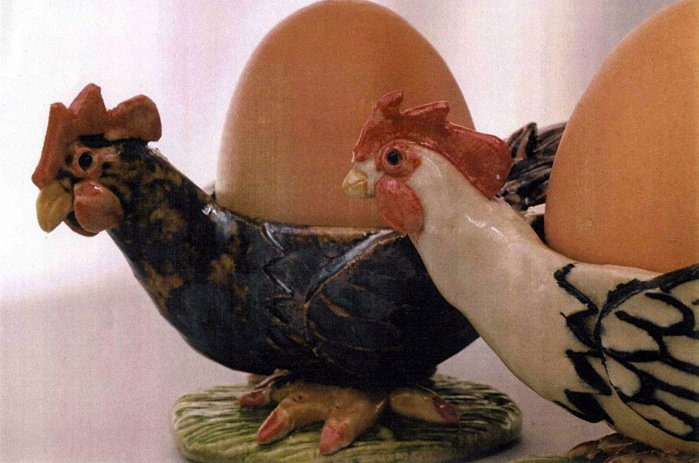
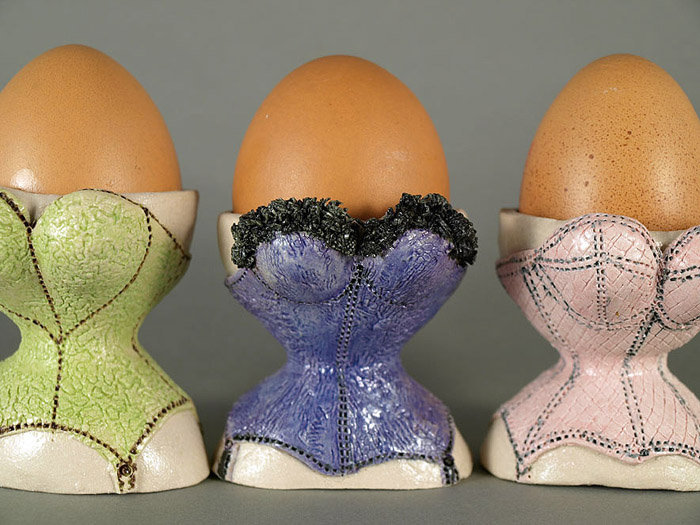
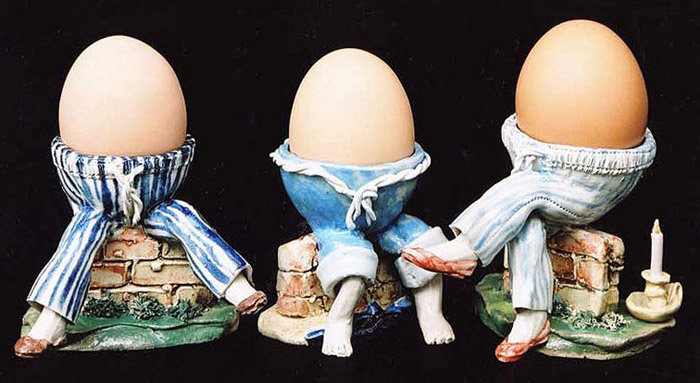
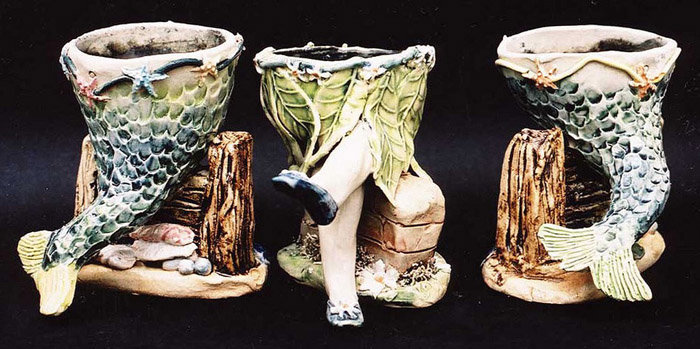
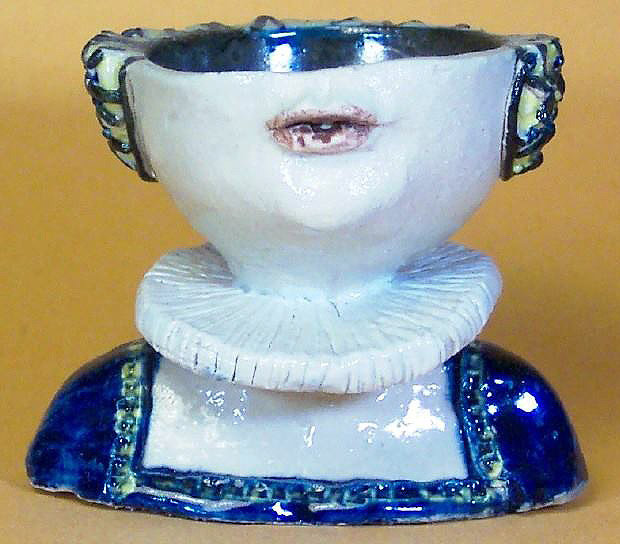
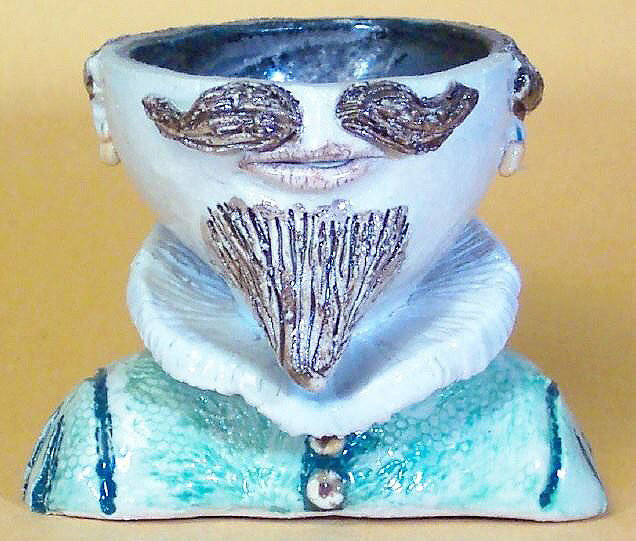
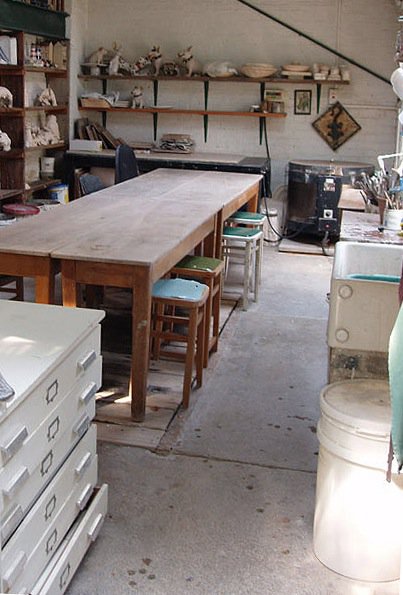
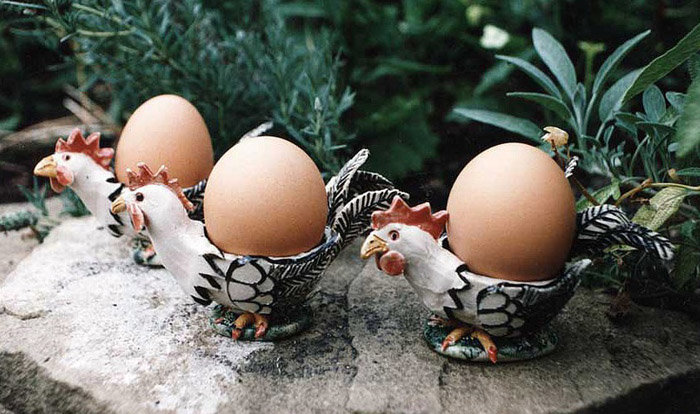
Photos: Anderson, Whimster et al © Nico Diener, Deutsches Eierbechermuseum
Translation: Lesley Kilby
Sarah Kay Collection 
The timeless imagery of Sarah Kay can be seen on egg cups by various manufacturers. The mother of these wonderful children's pictures is the Australian artist Vivien Kubbos. In the 1970s and 80s Sarah Kay books were very popular, particularly with girls, and these became a well-loved part of childhood of several generations. The innocent charm of Sarah Kay fell out of favour in the 80s. However, Sarah Kay is classic and timess, and we should not be surprised if further egg cups with pictures by Vivien Kubbos appear on the market.
»World Champions« traveling 
It's no secret: Riek and Ad Koetsier from Epe in Holland have the world's largest egg cup collection (see below). Since for many years they have also been buying entire collections the double »Eierdopjes«, as the Dutch say, are piling up in their barn. Reason enough to publicly offer them once again for sale.
Last weekend they built their booth on the Easter Market in the peaceful German town Hameln. The stand with the many egg cups was very well received Riek and Ad enjoyed the weekend, the atmosphere and the conversations with the visitors. The sale covered the booth fees and room and board in Hameln. On Monday they visited the historic heart of the "Pied Piper City" and then headed home.
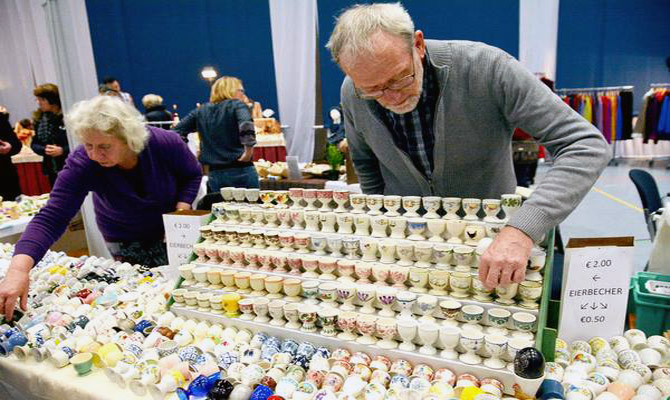
On the weekend of March 7th and 8th the two of them can be seen with their egg cups-booth on the Easter-egg Market in Filsum (Ostfriedland) and they will be happy to receive visiting collectors. For those for whom the journey is too long, they still do not have to miss out on the offers. Under http://www.eierdopjes.nl/ruilned.html anyone can check out the huge amount of double egg cups and exchange with Riek and Ad or buy from them. These small vessels can be purchased for incredible prices from 0,50 to 4,00 Euro.
Photos: Archiv Koetsier © Nico Diener, Deutsches Eierbechermuseum
Translation: Dr. Anna de Vincenz
Canteen dishes in the "Third Reich" 
The Nazi "Amt Schönheit der Arbeit" (Office Beauty of Work) in Berlin decided in 1935 to design a table-ware simple, functional and suitable for the masses, which would be used in factory canteens for the aesthetic improvement of working conditions. This included also egg cups. This table-ware existed in four model series and seven different colors. In addition, there were production lines, which had the logos of large firms, shipping companies and government institutions such as the "Deurag-Nerag" and the "Nordischer Lloyd".
The design is inspired by the functionalism of the Werkbund era of the 1920s. During the Nazi era, there was no uniform design, existing trends were taken on and reinterpreted in the Nazi way.
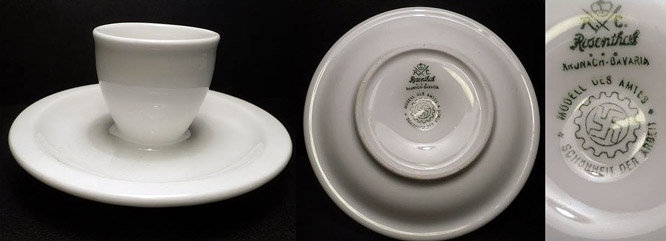
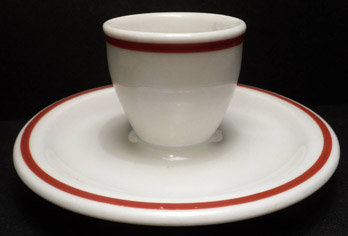
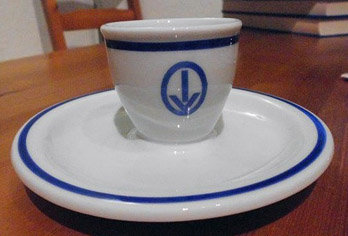
These egg cups form model I were created by the designer Heinrich Löffelhardt 1935/36 and produced by Rosenthal-Selb. The strange thing about them is that the Jewish name Rosenthal came to stand above the swastika symbol.
Photos: Siebert, Hespenheide © Nico Diener, Deutsches Eierbechermuseum
Translation: Dr. Anna de Vincenz
The name "Deurag-Nerag, "Nordischer Llyd" and "Rosenthal" arw protected by law. The use here facilitates the exact description of the exhibits and their origin.
Maria Theresia – the queen among egg cups 
Since 1926, this timeless china form has been manufactured by Hutchenreuther in Selb (Upper Franconia, Bavaria in Germany) in many different patterns. Today this is a brand of Rosenthal AG. Egg cups are not part of every dinner service – and not every egg cup belongs to a service. There are over 120 different known patterns but they do not all originate from Hutschenreuther, for other manufacturers bought and still buy white blanks blanks from them and decorate them with their own patterns.

Originally only intended to prevent the egg rolling off the breakfast table, the egg cup has evolved into its own work of art. The model “Maria Theresia” offers simple timeless elegance. Here the pattern “Schloss Linderhof” in green (original Hutschenreuther *).

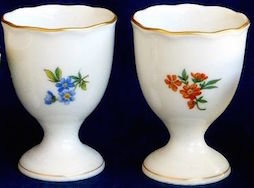

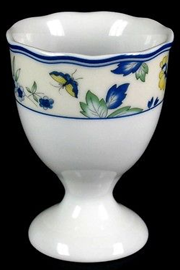
Weiß Mirabell Weinlaub Papillon
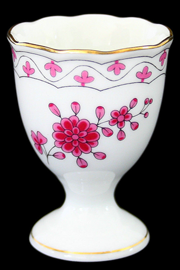



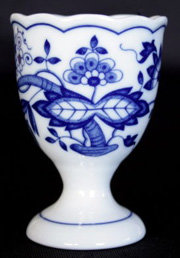
Schloß Linderhof rot Schloß Linderhof rot Schloß Linderhof rot ? Zwiebelmuster
"7 Uhr" "1 Uhr"
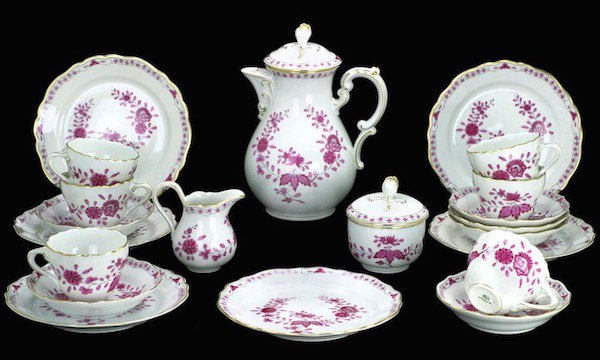
Decor »Dresden Pergola" (from 1970)
The suggested retail price of Hutschenreuther
was in 1992 in the 21-piece coffee service version 1.300, - DM
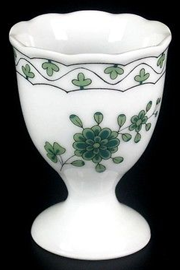



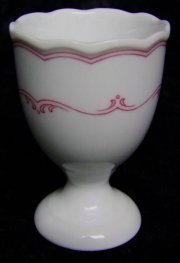
Schloß Linderhof grün Schloß Linderhof grün Schloß Linderhof grün Schloß Linderhof grün Mainau
"7 Uhr" "9 Uhr" "1 Uhr"
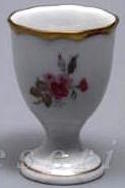
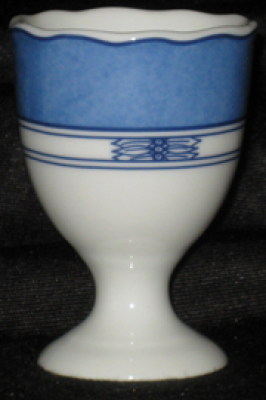
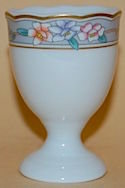

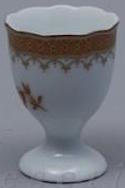
Residenz Scandic Blue Fürstenau kobaltblaue Rose Würzburg
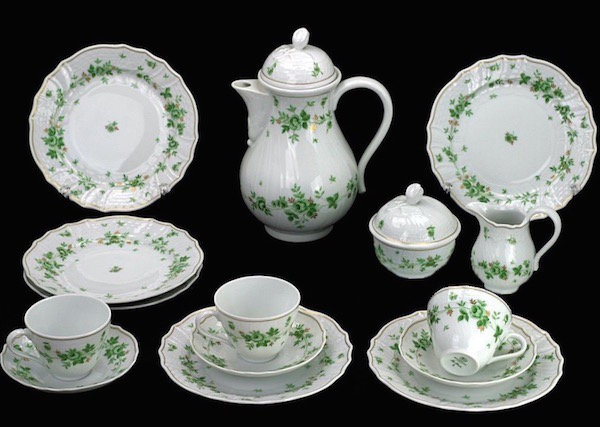
Decor »Dresden Pergola" (from 1970)
The suggested retail price of Hutschenreuther
was in 1992 in the 39-piece coffee service version 1.900, - DM




 ??? Burgund rosa Burgund blau Erimitage Monatsbecher
??? Burgund rosa Burgund blau Erimitage Monatsbecher
O. Winther, mehr davon
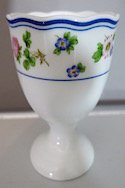
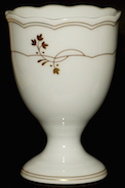

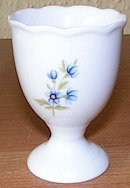
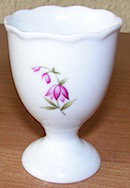
??? Schloss Bentheim Miramar ???
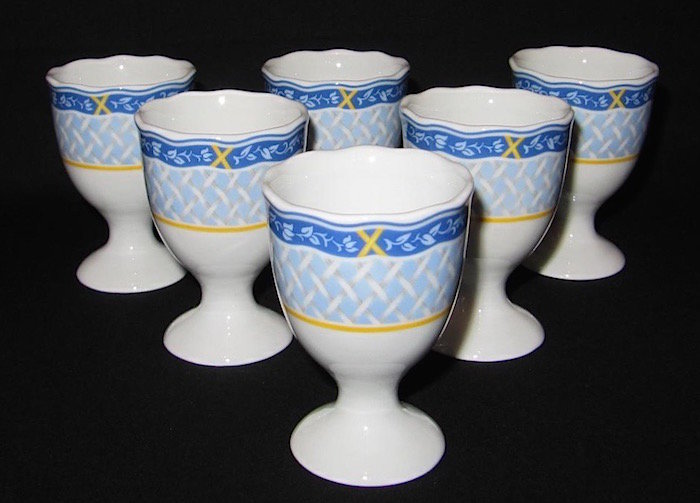
Dekor »Frühlingsboten«


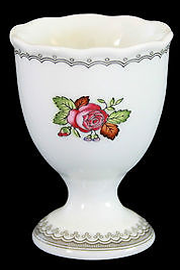


??? Arabella Arabella ??? Marburg
Deco flower upside down



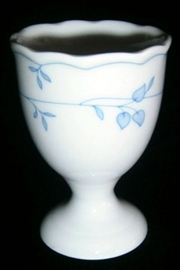

Prater Dresden Pergola Seehof rosa Seehof blau Rheinsberg
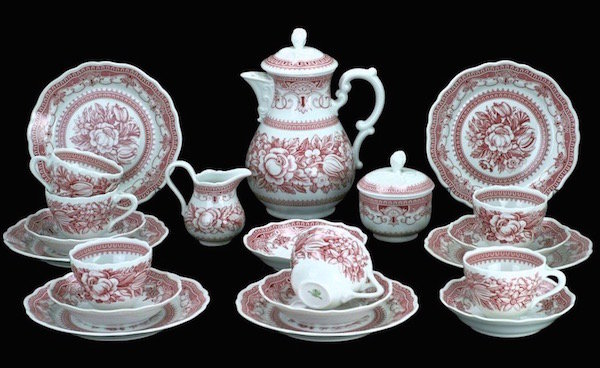
Decor »Windsor Red"
The suggested retail price of Hutschenreuther
is in the 21-piece coffee service version 689, - €




 Medley Valdemossa Medley Mantova Medley Tierra Medley Finca Medley Vicenza
Medley Valdemossa Medley Mantova Medley Tierra Medley Finca Medley Vicenza


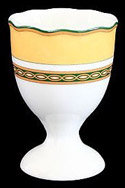
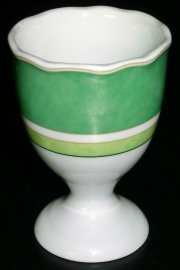
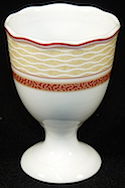 Medley Winterzeit Medley Parklane Medley Alfabia Medley Sommerdream Medley New England
Medley Winterzeit Medley Parklane Medley Alfabia Medley Sommerdream Medley New England
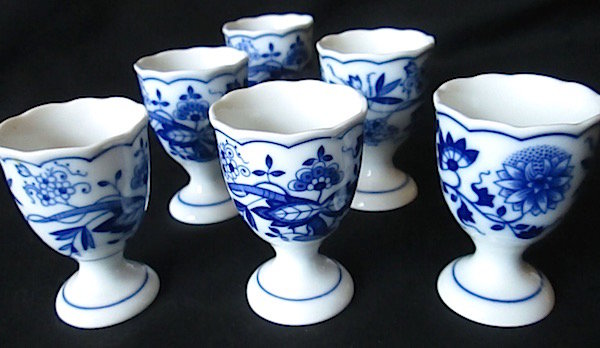
Dekor »Zwiebelmuster«
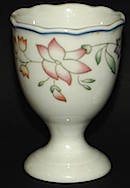
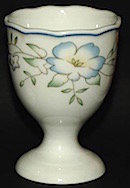

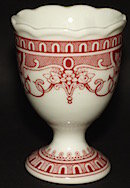
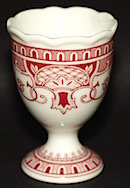 Hofgarten Windsor Blau Windsor Rot
Hofgarten Windsor Blau Windsor Rot


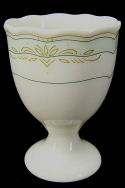

 Schlossgarten Carmino Königstein
Schlossgarten Carmino Königstein
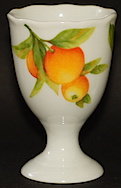
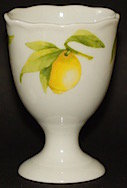

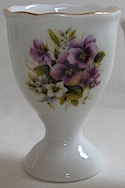
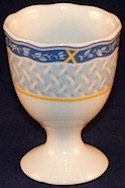 Paradies Stiefmütterchen Frühlingsboten Residenz
Paradies Stiefmütterchen Frühlingsboten Residenz
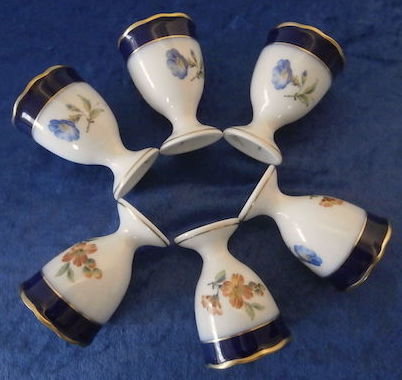
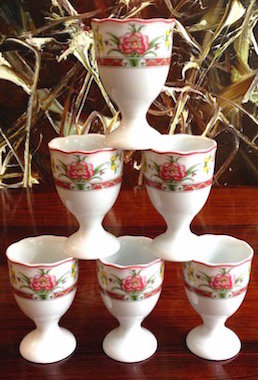 Rheinsberg Carmino
Rheinsberg Carmino
Hutschenreuther Senator Design





Tummelisa ´77 Nils Holgersson ´78 Första Mästerkatten ´79 Aladins Lampa ´80 Kejsarens nya Kläder ´81
(Thumbelina) (The Wl. Adventures of Nils) (Puss in Boots) (Lamp of Aladdin) (The Emperor's New Clothes)
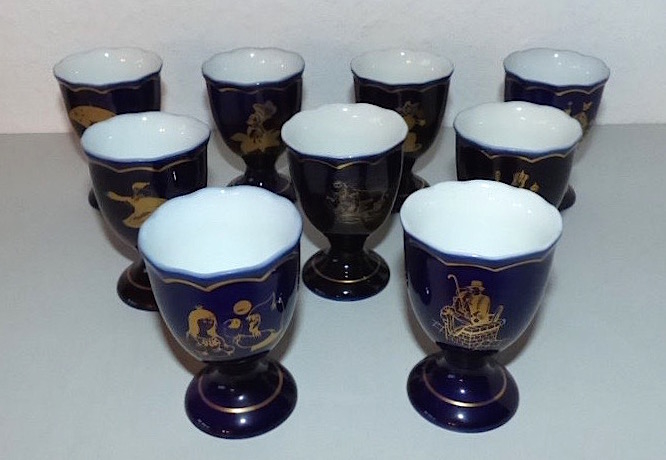





Herdinnanoch ´82 John Blund ´83 Snövit ´84 Hans o Greta ´85 ??? '86
(The shepherdess) (Sandman) (Snowwithe) (Hansel and Gretel) (???)
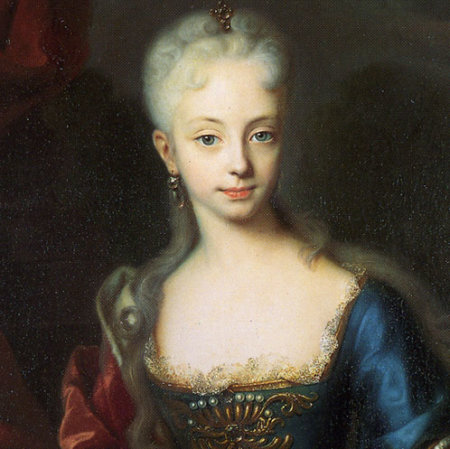
The namesake of this successful series of Hutschenreuther
Maria Theresia 1717-1780
Patters from other manufacturers
Alt Tirschenreuth (D)
(1927 bis 1994 Zweigniederlassung der Lorenz Hutschenreuther AG in Selb)
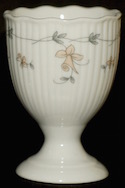

Serie Salzburg
Decor ? Decor Rosengarten
Pressed by Reutter (D) under licence and decorated with their own patterns
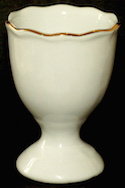
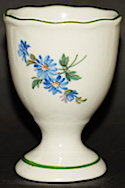
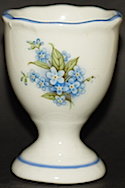


withe ? ? ? ?
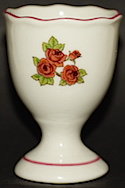


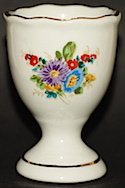
 ? ? ? ? ?
? ? ? ? ?
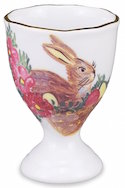
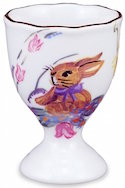
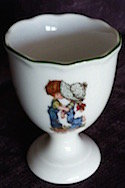

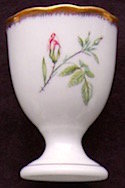
Osternest Osterhase Motiv from Sarah Key ? ?
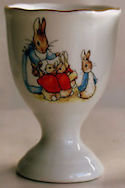
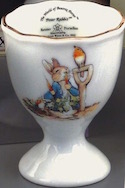
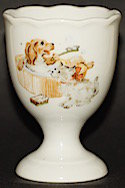

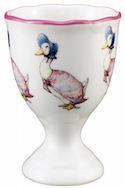 Mrs. Josephine Hase ? ? Peter Hase Emma Entenkopf
Mrs. Josephine Hase ? ? Peter Hase Emma Entenkopf
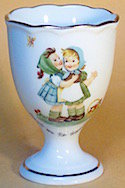

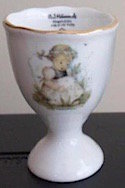

? ? ? ?
Patterns by Hackefors (S) on Hutschenreuther whiteware





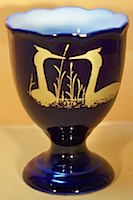

Patterns by Ravn (S) on Hutschenreuther whiteware




"Maria Theresia", Kobaltblau from Hackefors (S), Hutschenreuther (D) and Ravn (S)
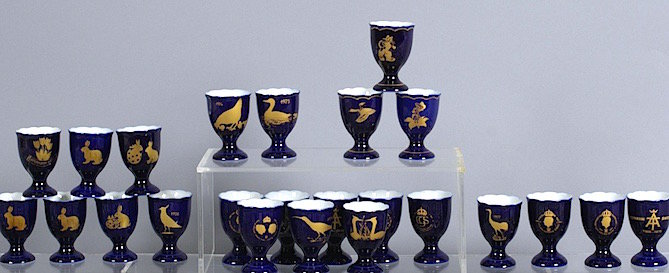
*Original Hutschenreuther Egg cup from the series "Maria Theresia"; the expert recognizes the fact that, barely visible, they are seamed horizontally foot and cup. Those produced under license by Reutter have two vertical composite stampings. The vertical seam is clearly visible upon closer inspection.
Photos: Diener, Koetsier, Anderson et al © Nico Diener, German Eggcup Museum
Translation: Dr. Anna de Vincenz and Lesley Kilby
The name "Hutschenreuther", "Hackefors", "Ravn" and "Reutter" are protected by law, such use is only the detailed description of the exhibits and their origin.
Big Bellied Egg Cups 
The shape of this egg cup is derived from the Greek Campana vases and was very popular in the 19th century. Such egg cups were produced mainly by English porcelain factories Davenport, Spode, Barr & Barr, Copeland, St. George and Wedgwood. But the Royal Porcelain Manufactory Berlin (KPM) made use of this form from 1857 to 1849. While Marianne and Manfred Haack speak of “crater-shape” in their book »Alte Eierbecher«, Brenda C. Blake calls them simply “French” in her book »Egg Cups«. However, the description »Medicis-forme« is common in France. An additional name, used by English-speaking collectors for this bulbous shape is "urn". Many of these beautiful pieces are not marked, so that it cannot always be established which factory made them.
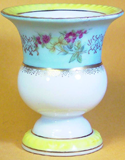
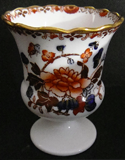
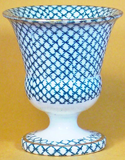
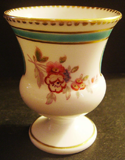
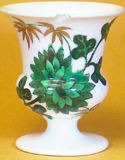 Copeland* Copeland
Copeland* Copeland
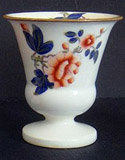
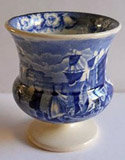
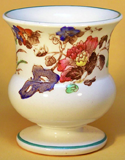
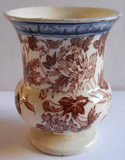
Wedgwood, Ferrara *

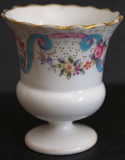
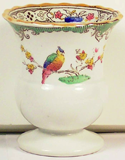
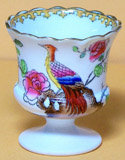
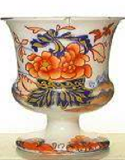
Copeland *
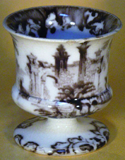
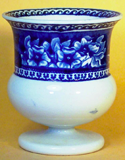
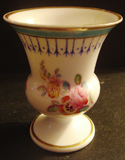
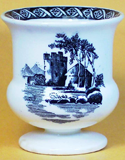 Wedgwood Copeland
Wedgwood Copeland
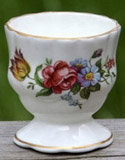
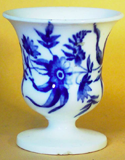
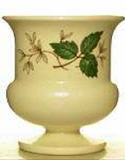
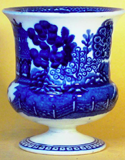
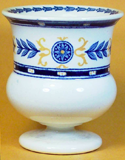
Wedgwood Wedgwood
The Copeland Spode's Manufactory produced
until the 1950s this version without foot
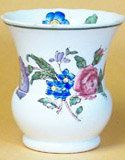
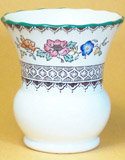
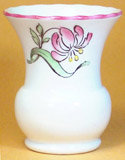
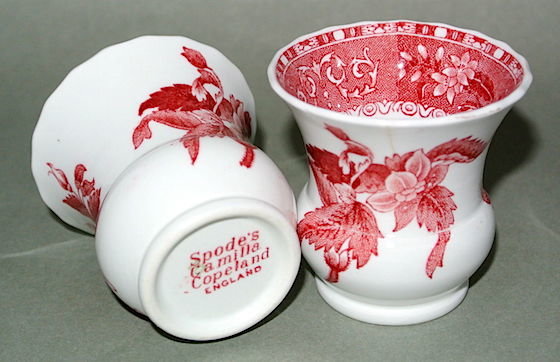
Spode's Camilla Copeland
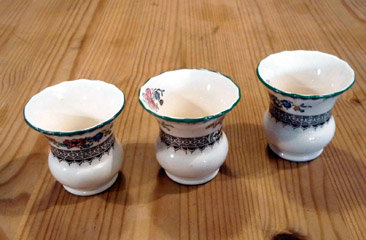
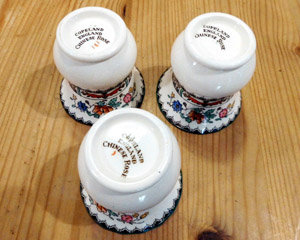
Copeland, Chinese rose, circa 1950
* = These patterns are English interpretations of Japanese Imari gold decors.
Photos: George, Diener, Koetsier, Anderson et al © Nico Diener, German Eggcup Museum
Translation: Dr. Anna de Vincent
The name "Davenport", "KPM", "Barr & Barr, "St. George", "Wedgwood", "Spode" and "Copeland" arw protected by law. The use here facilitates the exact description of the exhibits and their origin.


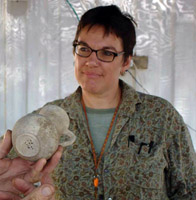 Dr. Anna de Vincenz is an archaeologist from Jerusalem and works for the "Israel Antiquities Authority". As a ceramic specialist, she is a consultant for Israeli and foreign institutions. At present she also works with the University of North Carolina at Charlotte (UNCC). Anna can be contacted by email at annasolari(at)gmail.com and on Facebook at Anna De for any archaeological and historical queries.
Dr. Anna de Vincenz is an archaeologist from Jerusalem and works for the "Israel Antiquities Authority". As a ceramic specialist, she is a consultant for Israeli and foreign institutions. At present she also works with the University of North Carolina at Charlotte (UNCC). Anna can be contacted by email at annasolari(at)gmail.com and on Facebook at Anna De for any archaeological and historical queries.





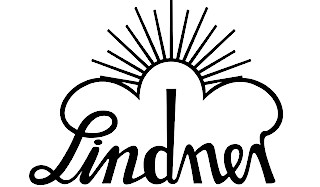







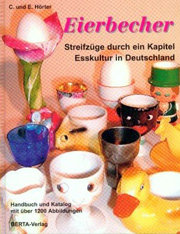
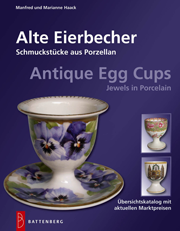
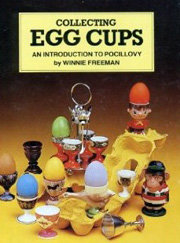
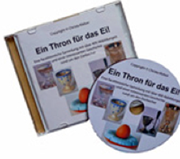
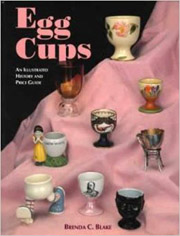

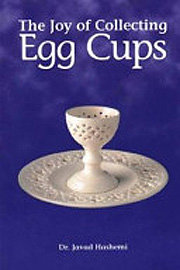
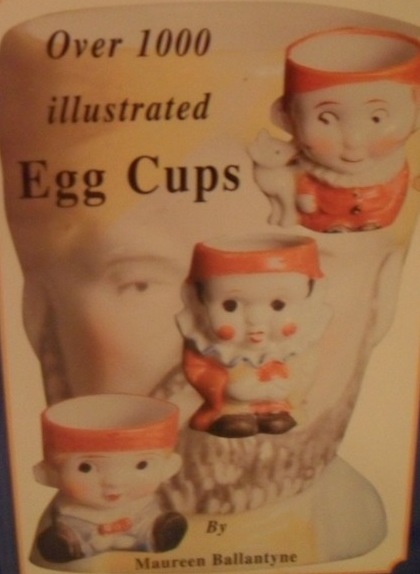
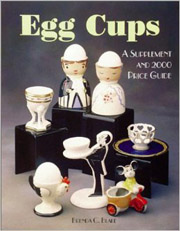
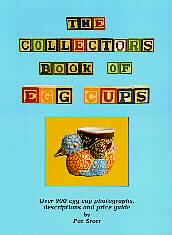 ISBN 0969753209
ISBN 0969753209